Most of us are chowing down on flowers all the time without realizing it. Broccoli, cauliflower, and artichokes are all flowers, or flower buds.
Clearly, the part of the plant that we often think of as only being valuable for its looks can be incredibly tasty as well.
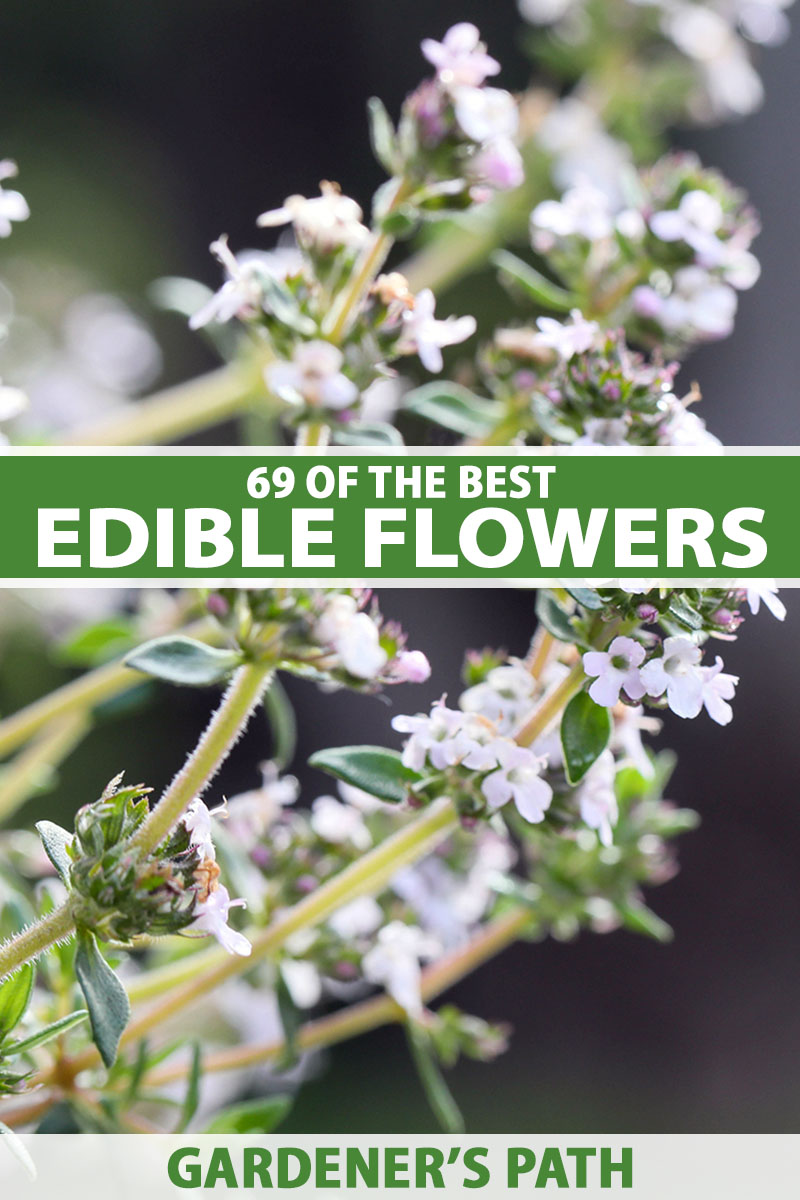
We link to vendors to help you find relevant products. If you buy from one of our links, we may earn a commission.
That’s why you shouldn’t write off your more ornamental plants. A shocking number of them are far more than just pretty faces.
Begonias have a fresh citrus crunch and carnations are as sweet as can be. Daylilies taste like green peas and honey, and gardenias are far too delicious to waste in corsages.
Throughout history, eating certain species of flowers has come in and out of fashion.
Some plants that we use to pretty up our yards today used to be more valued as edibles. And we’re not just talking about candied violets on a cupcake. Flowers can be used in any dish you can imagine.
Whether you want your plants to do double-duty or you are dying for something new to put on the plate, this guide will introduce you to dozens of blossoms you can not only eat, but many that are so tasty you might find yourself planting them alongside your veggies instead of in your ornamental beds.
Here are the varieties we’ll discuss:
69 Incredible Edible Flowers
Most herb flowers are edible – tarragon, thyme, oregano, sage, and the like – but unless they’re particularly unique or have a distinct flavor from that of the leaves, we left these off the list.
Feel free to eat them whenever they’re present – most of them will taste pretty similar to the leaves.
The same goes for plants in the Brassicaceae family. Mustards, in particular, produce flavorful flower nuggets.
Also, you should avoid washing the flowers until you’re ready to eat them, unless noted otherwise. Pretty much all types of blossoms should be eaten fresh.
If you use them in hot dishes, wait to add them until you’re nearing the end of cooking, or just before serving. We’ll let you know when this isn’t the case.
If you’re harvesting out of the garden or foraging, make sure the blooms you pick haven’t been sprayed with chemicals recently.
Or, if you decide to run to a nursery to pick up a six-pack of plants to use at a dinner party, do it in advance so you can deadhead the existing blossoms and let new ones grow that you can safely pluck and serve.
Note that some people discover that they have an allergy that they didn’t know about when they try new foods.
For instance, consuming daylilies may cause an allergic reaction in some people. Try a little nibble of any new species that you try and then wait for a few hours before diving in head first.
1. Acacia
You probably seen acacia flowers (Acacia dealbata, aka mimosa tree) hanging in clusters from trees or in florist bundles.
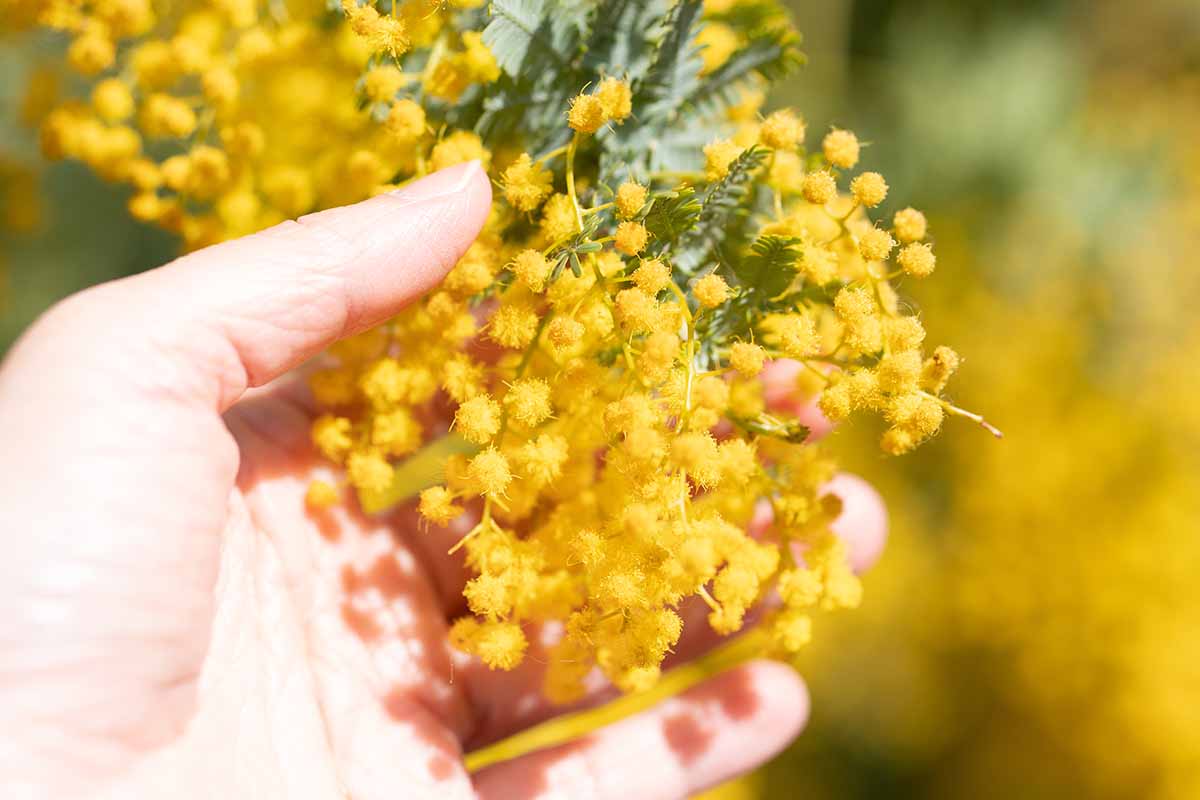
Wherever you’ve spotted the distinctive, fuzzy flowers, you probably didn’t imagine popping them in your mouth.
You should, though. Thomas Jefferson once said that mimosa was “the most delicious flowering shrub in the world” and the only plant besides the orange that he would bother nurturing in his greenhouse.
It has a honey sweet, floral flavor and can stand up to cooking.
In fact, that’s how most people use them, since the fuzzy bits can be a bit strange to chomp down on. I like them chopped up or crushed to reduce the furriness, but I think the flavor is best raw.
Don’t eat the ones you find in a floral display, by the way, unless you are absolutely, 100 percent sure they are Acacia dealbata.
Other members of this genus can be toxic. You should also be sure that the flowers haven’t been sprayed with chemicals. In other words, it’s probably best to stick to the ones you pull off a tree that you can positively identify.
2. Allium
All blossoms in the Allium genus are edible, but not all of them taste great.
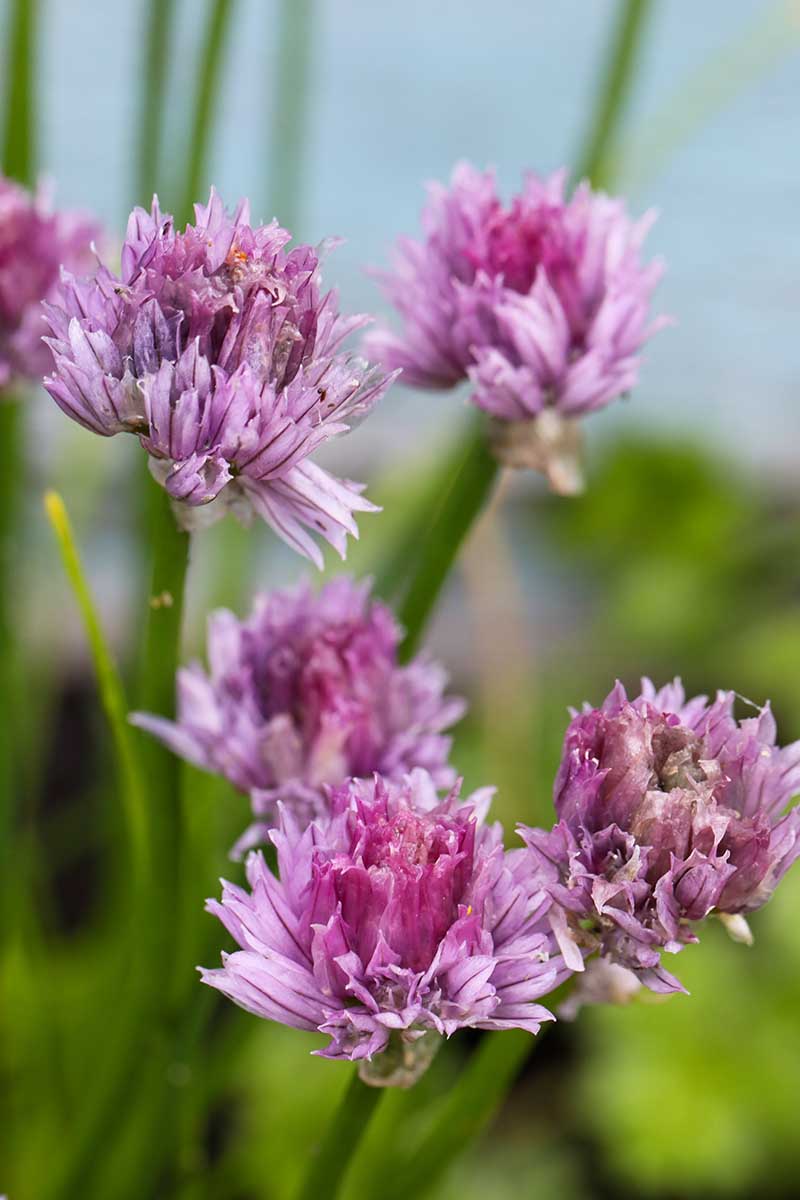
When it comes to choosing a flower with a hint of garlic or onion without much bitterness, stick with chives and leeks.
Garlic, onion, and ornamental allium flowers can make a pretty addition to a dish, but they tend to be a bit bitter or tough. Not all of them are, however, so experiment away!
Use these purple, pink, or white treasures to top cottage cheese, sour cream-based dips, on soup, in rice or on omelets, or on a shrimp sandwich – anywhere you want just a hint of onion flavor.
3. Anise Hyssop
The blossoms of anise hyssop (Agastache foeniculum) taste a lot like the leaves do, with a sweet, licorice-like flavor with just a hint of floral.
Anywhere you’d use the herbal leaves you can substitute the flowers, or you can toss them on salads, soups, pasta, or rice dishes.
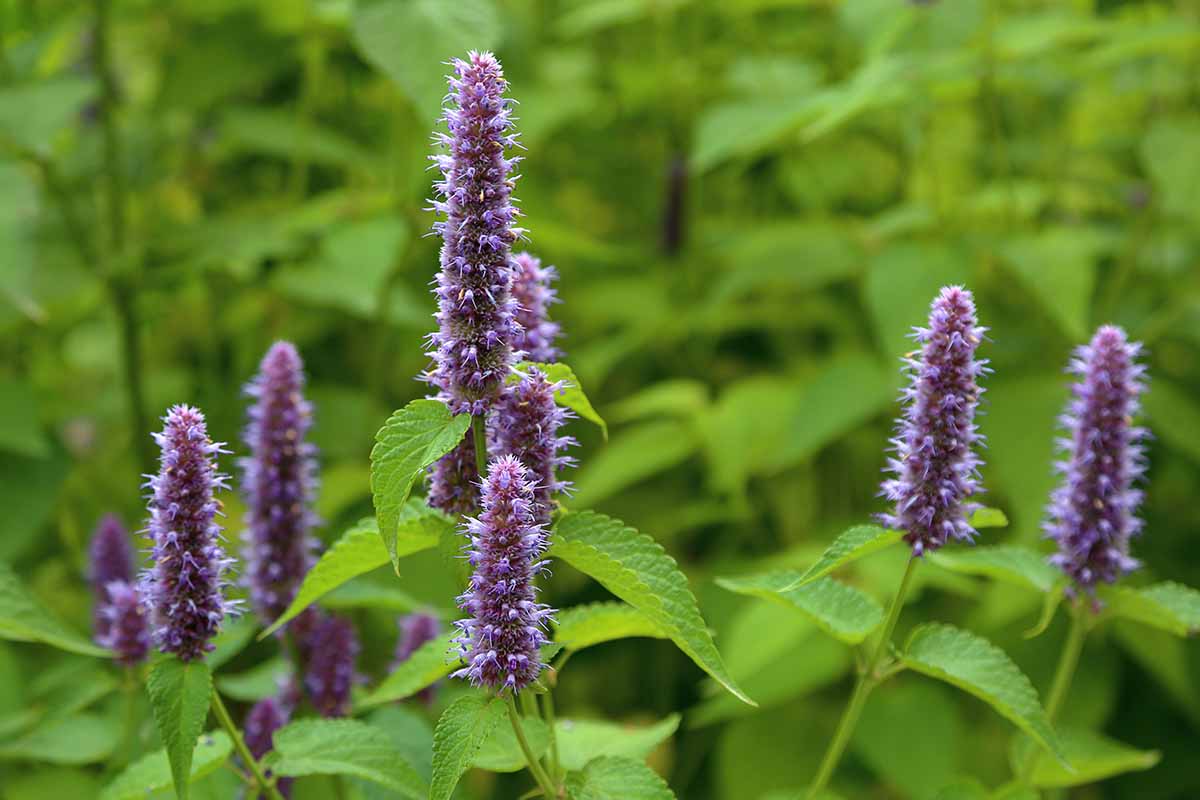
If you’re at a loss for how exactly to use them, just think about how you’d use rosemary or mint. Lamb, beef, chicken, salad, soups, pasta, rice – you name it, and you can probably figure out a way to put anise hyssop in it.
While you can eat the entire flower head if you chop it up finely, it’s better to pull the individual blossoms away from the fuzzy head before eating.
Learn how to grow anise hyssop flowers in our guide.
4. Bachelor’s Button
For a hint of cucumber and a whole lot of color, add bachelor’s buttons (Centaurea cyanus) to your salad or as a garnish for a dessert.

The cobalt blue of cornflowers makes them as striking in the garden as they are in the kitchen. Heap them on top of a pasta dish to wow your guests, or bake them into cakes and cookies for a natural pop of color.
The flavor has a bit of spicy sweetness that works well in both desserts and savory dishes.
Check out our guide to growing bachelor’s buttons to add these flowers to your garden.
5. Bee Balm
Wild bergamot (Monarda didyma) also known as bee balm, has a minty, slightly sweet, oregano-like flavor. In cooking, the vibrant color stands out as much as the flavor does.
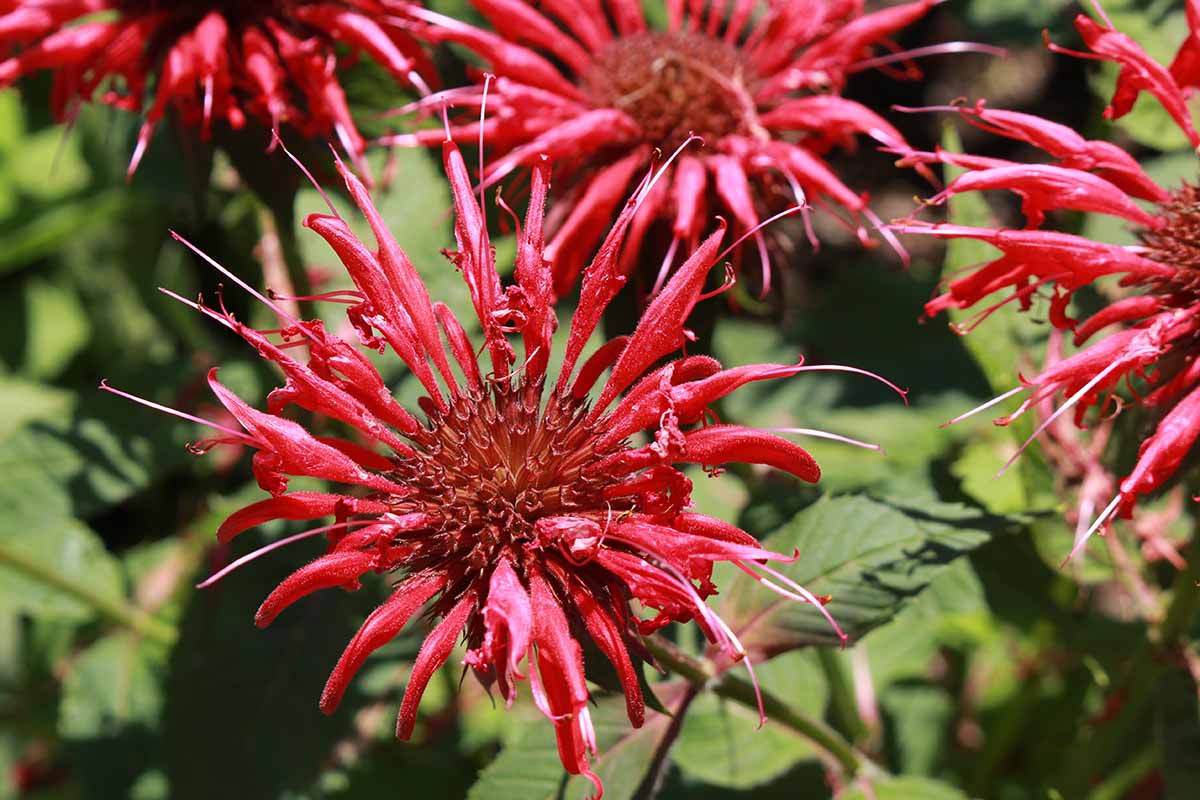
Just be sure to pluck the petals out of the calyx. You can eat the calyx if you cook it and slice it up finely, but if you want something herb-like, stick with the petals.
Bee balm makes a particularly good addition to salsa – along with an acid like lime juice, fresh herbs like cilantro or parsley, and tomatoes – but it’s also excellent in tea, bread, jam, cookies, and cocktails.
Learn how to grow bee balm in our guide.
6. Begonia
In shady spots around the globe, you can find various members of the Begonia genus blossoming away. But while they’re fabulous to brighten up a dark spot, many people don’t realize they’re also versatile cooking ingredients.

All begonias are edible, but wax (B. x semperflorens) and tuberous begonias (B. x tuberhybrida) are the tastiest.
The succulent petals have a cucumber-like crunch and a slight citrus flavor, which makes them lovely in veggie and fish salads. Try them chopped in panzanella and you’ll be a convert.
Don’t have a go-to recipe? start with this radish panzanella from our sister site, Foodal.
7. Berries
Berries make an excellent pick if you’re looking for edible flowers. All of the Rubus and Ribes species, as well as strawberries (Fragaria spp.), blueberries (Vaccinium spp.) and mulberries (Morus alba) have edible flowers.
Raspberries, blackberries, black currants, gooseberries – they’re all worth a taste!
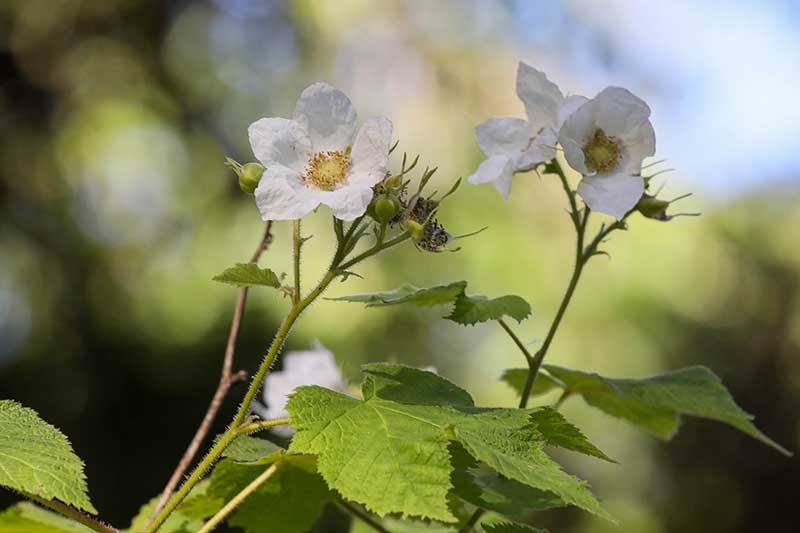
Remember that if you pull the flowers a fruit won’t form in that spot. The simple flowers are tasty, but nothing compared to the fruit themselves, so balance your hunger for blooms with your hunger for fruits and don’t overpick!
On the other hand, if your yard is overrun with brambles, you have lots of floral treats just waiting to be harvested.
8. Borage
Borage (Borago officinalis) takes basically zero effort to grow and the heavenly star-shaped blue flowers are as tasty as they are beautiful. With a flavor reminiscent of sweet cucumber, they add a special touch to salads, soup, fish dishes, or drinks.
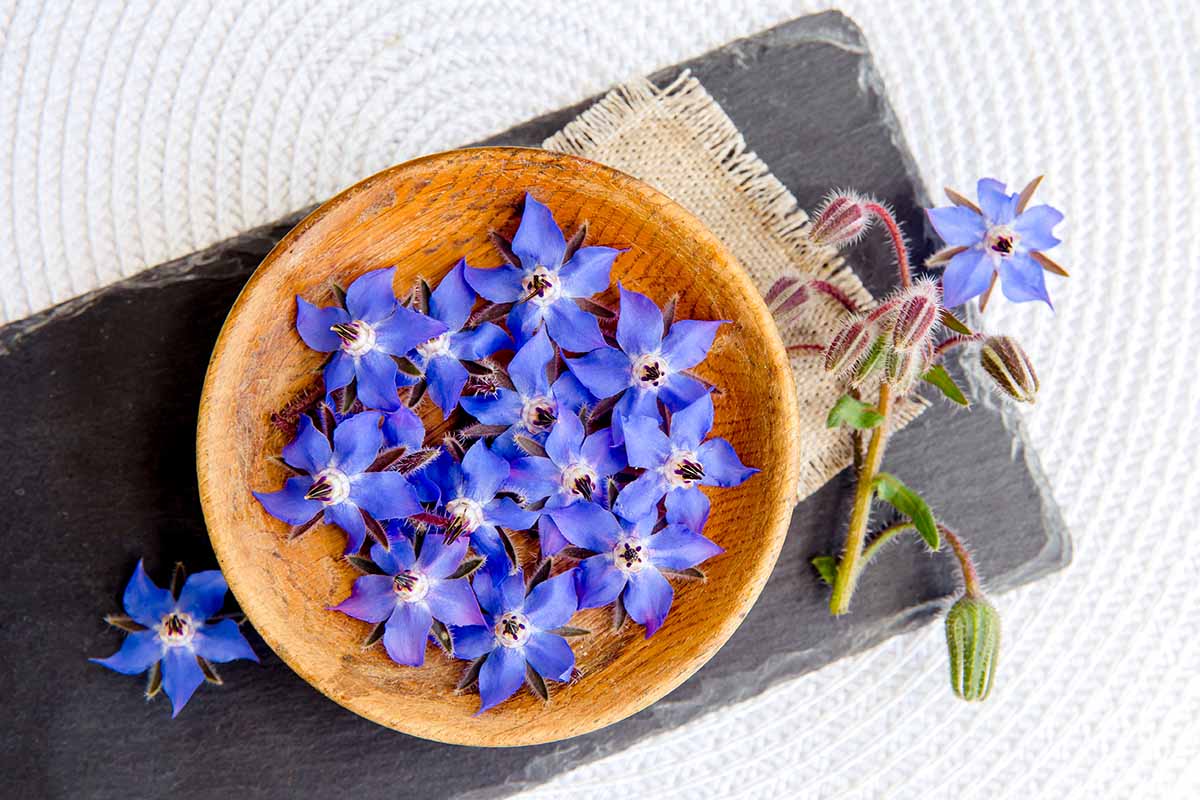
Toss them with tomatoes and cucumber in a vinaigrette or use them as a garnish in lemonade for a summer treat.
Borage is one of the best culinary flowers and it is one of few blue ones, to boot. If you don’t use all of yours right away after you pick them, wrap them loosely in a damp paper towel and place them in the refrigerator.
Learn how to plant and grow borage here.
9. Bougainvillea
With its thick vines and vivid flowers, bougainvillea (Bougainvillea spp.) has earned a place as a crowning glory in many gardens.
The so-called “flowers” are actually bracts, which are modified, colored leaves. This is the edible part. Toss out the small, narrow flowers attached to the center of each bract.

The bracts are best used fresh, though you can also steep them into tea, but don’t leave them in the hot water for more than five minutes or so. They lose their sweet flavor and begin to turn extremely bitter.
A homemade agua fresca made with cold water, lime juice, sugar, and bougainvillea bracts is particularly tasty.
Learn more about growing bougainvillea with our guide.
10. Calendula
Calendula (Calendula spp.) flowers are well-known for their ornamental and medicinal uses, and we even have a guide to walk you through using them for medicinal purposes.
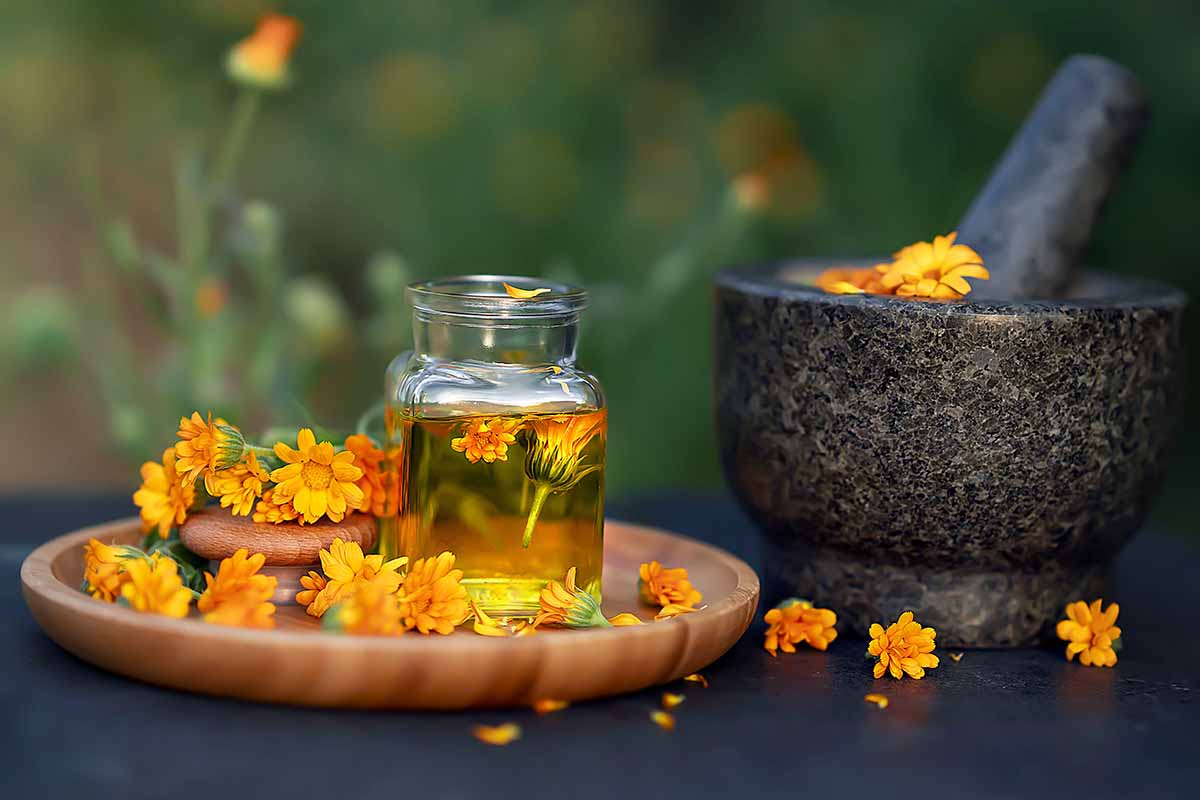
Also known as pot marigolds, as with other types of marigolds (Tagetes spp.), you can use them to color dishes as you would saffron, with a lovely orange hue. These flowers lack the distinct flavor of saffron though.
Use calendula to infuse oils and butter, or in fish dishes like salads and paella. Or bake it in a batch of shortbread or scones enhanced with the blooms.
You can learn how to grow calendula in our guide.
11. Camellia
Camellias (Camellia spp.) are showy and sweet, which makes them ideal as a garnish for desserts or fruit salads.

You can also candy the petals to put on cakes, cookies, pastries, and other confections. You can learn how to make candied blooms on our sister site, Foodal.
Learn how to grow camellia flowers in our guide.
12. Carnations
Here we’ve been enjoying our happy little get-well carnation (Dianthus caryophyllus) bouquets and then tossing them into the trash, when we could have been eating them all along.
Well, maybe not if that bouquet came from the grocery store or florist and we can’t know for sure whether the blooms have been treated with chemicals. But you understand the sentiment.
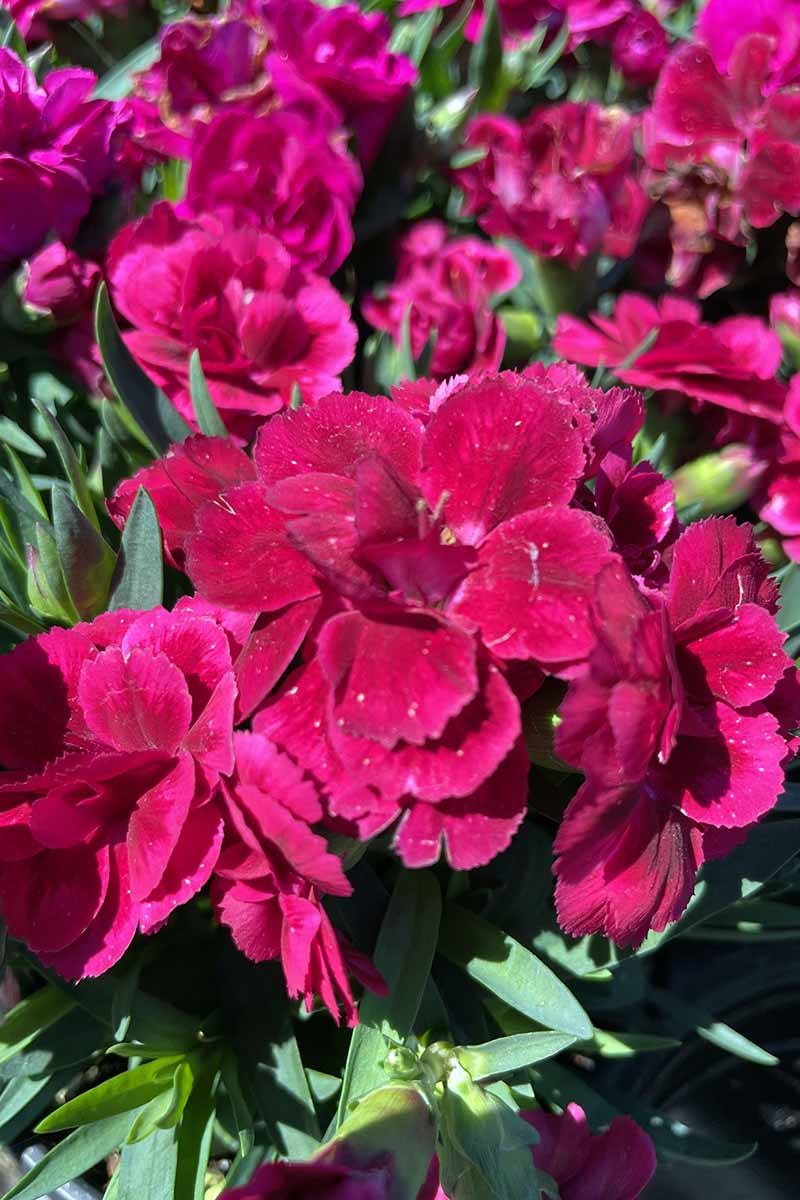
Perhaps knowing that they’re edible will help to make them more popular in gardens, since carnations seem to constantly be going in and out of style.
While you can certainly eat the ones you buy at the florist, if you know they were raised and arranged without being sprayed with any potentially toxic chemicals, it’s best to grow your own in the garden.
They’ll be more tender and flavorful that way – and you won’t have to worry about any inedible additives.
Carnations are extremely sweet and slightly floral. They’re actually used as an ingredient in chartreuse liqueur for that reason. Trimming away the heels to remove any bitterness is recommended, but even if you don’t, these flowers will still be sweet.
The petals are fantastic in strawberry jam, pies, and salads, as a topping for desserts, pickled in apple cider vinegar with cinnamon, or candied. Try adding them to fritters or crepes as well.
Find tips on growing and caring for carnation flowers here.
13. Chamomile
If you’ve had chamomile tea, then you know what this flower tastes like. But Matricaria chamomilla and Chamaemelum nobile have an apple-like flavor that lends itself to so much more than hot brewed beverages.
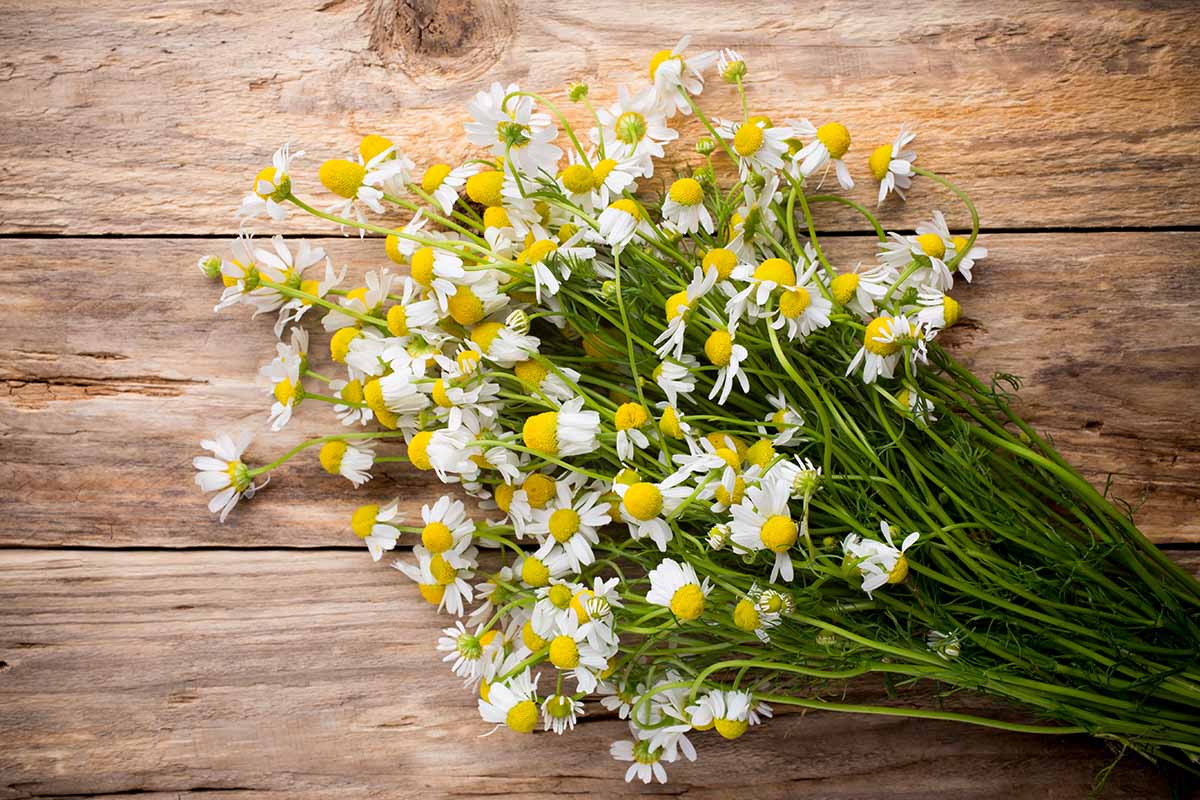
Toss the daisy-like heads into miso soup, oatmeal, cereal, salads, cocktails, or biscuit batter. They also taste fantastic in sweeter foods like jam, ice cream, candy, or cakes. Anywhere a little hint of apple would be nice is a good option.
Check out our guide to learn how to grow chamomile.
14. Chicory
Chicory (Chicorum intybus) flowers open for one day and then they’re gone, which I think makes them a little special. And their vibrant blue-purple hue makes them all the more welcome in the garden and on our menus.

This wild relative of radicchio shares the bitterness of its cousin, so use these blossoms sparingly. Just a little hint in a salad or veggie dish is plenty.
Our guide to growing chicory provides cultivation instructions.
15. Chrysanthemum
Undeniably elegant, chrysanthemums (Chrysanthemum spp.) are classic beauties. Place a few mums in your kitchen window and you’ll have a steady supply of colorful petals to add something special to your cooking.
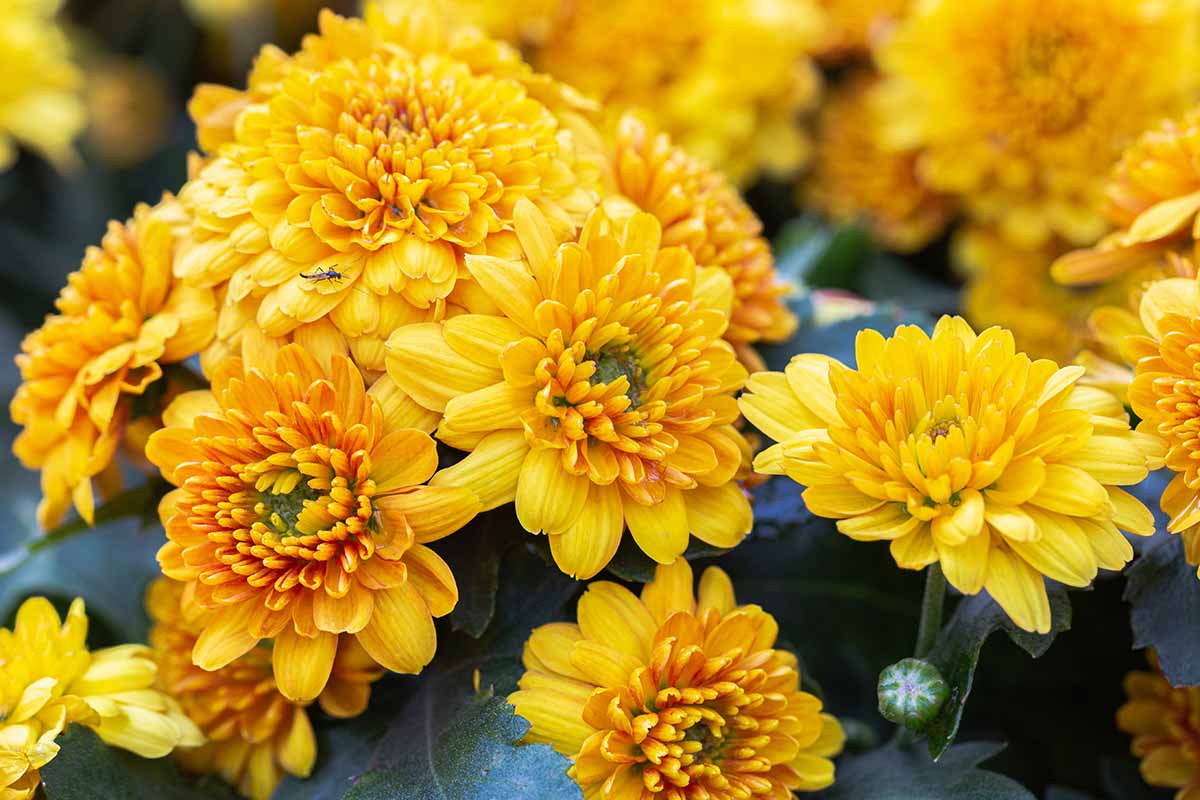
Rinse the petals thoroughly before using, especially if your mums were growing outdoors.
Bugs can hide easily in all those nooks and crannies. I like to soak mine for a few minutes in cold water to drive out any hitchhikers. Allow them to dry on a towel before using.
Next, it’s time to remove the heels to reduce the bitterness. Grasp the stem of the plant and pull the petals out with your fingertips. Trim off the white parts with shears while you’re still holding them. Place the prepped petals in a bowl and repeat.
Add mum petals to fish dishes, soup and chowder, salads, stir-fries, egg dishes, potatoes, and sandwiches. Blanching or soaking them in salty water for 15 minutes gives the petals a milder flavor if you find them to be too strong.
Learn more about growing chrysanthemums in our guide.
16. Citrus
It doesn’t matter if you have lemon, lime, orange, grapefruit, or kumquat trees, the blossoms of all Citrus genus trees are equally edible, and all taste just about the same.
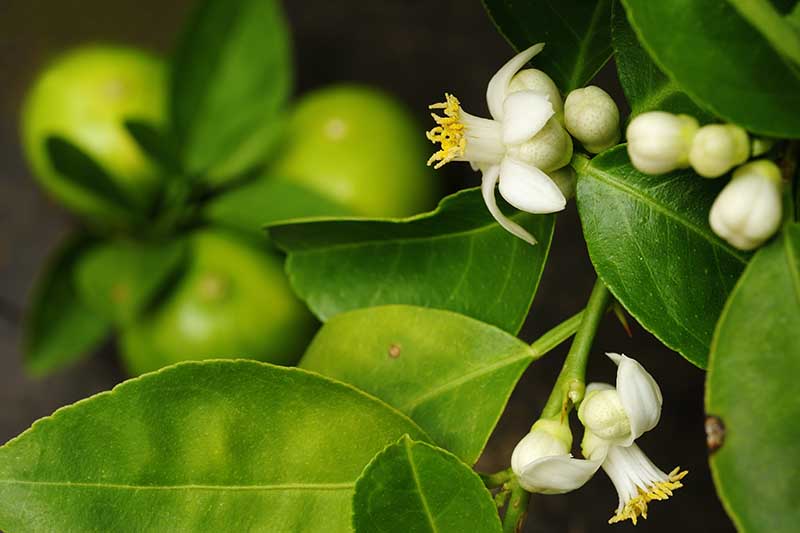
Add them to cocktails, desserts, sweet salads, crab plates, cold soups, fish or chicken plates, souffles, or ice cream.
If you haven’t had crab salad with citrus blossoms you haven’t lived! Really, anything that tastes good with some citrus flavor in it can be just as good with a few delicate blossoms instead.
17. Clover
Bees love them but some gardeners dread the sight of a patch of clover (Trifolium spp.) in the backyard. Regardless of how you feel, the pretty little flowers are worth a nibble.
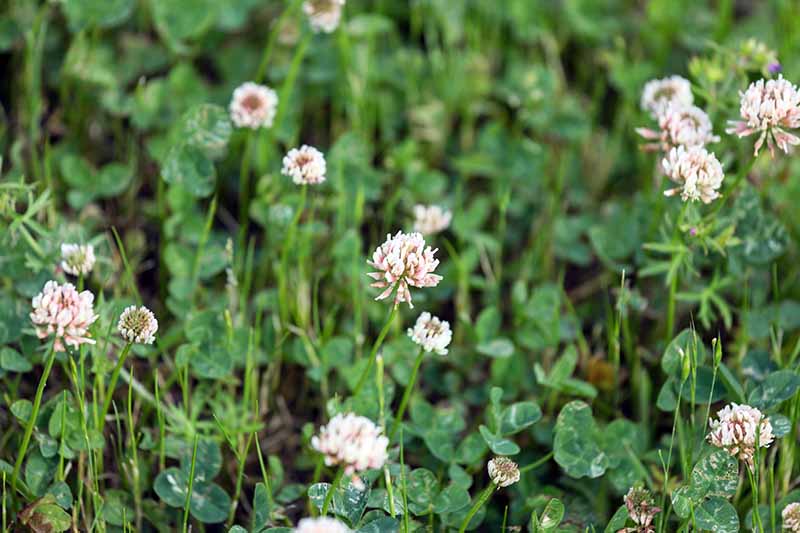
One taste and I’m guessing you’ll fall in love. That’s because they have a sweet, honey-like flavor that many children take advantage of when they pluck a bloom and suck out the nectar.
You can dry the flowers after washing them as you would any herb. That way, you can enjoy them all winter long. Just don’t pick and use any flowers that are already turning brown. They’re not very palatable.
Clovers are delicious as tea, on eggs, in compound butter, baked into bread, or on salads.
18. Coneflower
Coneflowers (Echinacea spp.) are North American treasures. They’re medicinal wonders, ornamental stars, and they’re also prolific growers that are seemingly immune to most problems that can take down other common garden species.

The flower petals of all Echinacea species are not only edible, but I personally find them to be delicious. Not everyone agrees.
They are admittedly a bit bitter and they have an extremely spicy, floral flavor. Cultivars with fragrant flowers such as ‘Fragrant Angel’ have less bitter petals.
Green-headed coneflower – also known as shochan or Rudbeckia laciniata – is the tastiest species by far, though it isn’t technically an Echinacea species of “coneflower.”
Not only do these plants share the common name “coneflower,” they actually belong to the same tribe within the Asteraceae family, Heliantheae, and they’re very closely related.
The Cherokee people have been eating this type of coneflower for centuries and it’s well worth seeking out.
Pluck the petals out of the head and toss them into soups or salads, particularly those that can stand up to a stronger flavor, such as panzanella.
A lot of people put echinacea root into chicken soup as a winter cold-busting tonic, but I like to be able to taste the flowers. I love Thai or Mexican chicken soup with a bunch of petals tossed on top before serving.
If you’re looking for an excellent instant pot Mexican chicken soup recipe, visit our sister site, Foodal.
Don’t eat the closely related black-eyed Susan flowers (R. hirta). While the roots are edible, the flowers and seed heads should be avoided. The petals aren’t toxic, but some people experience allergies when consuming them, and they don’t taste very good. The seed heads are mildly toxic.
Learn more about growing coneflowers here.
19. Cosmos
Not all cosmos are edible. In fact, you should stick to Cosmos sulphureus and C. caudatus exclusively.
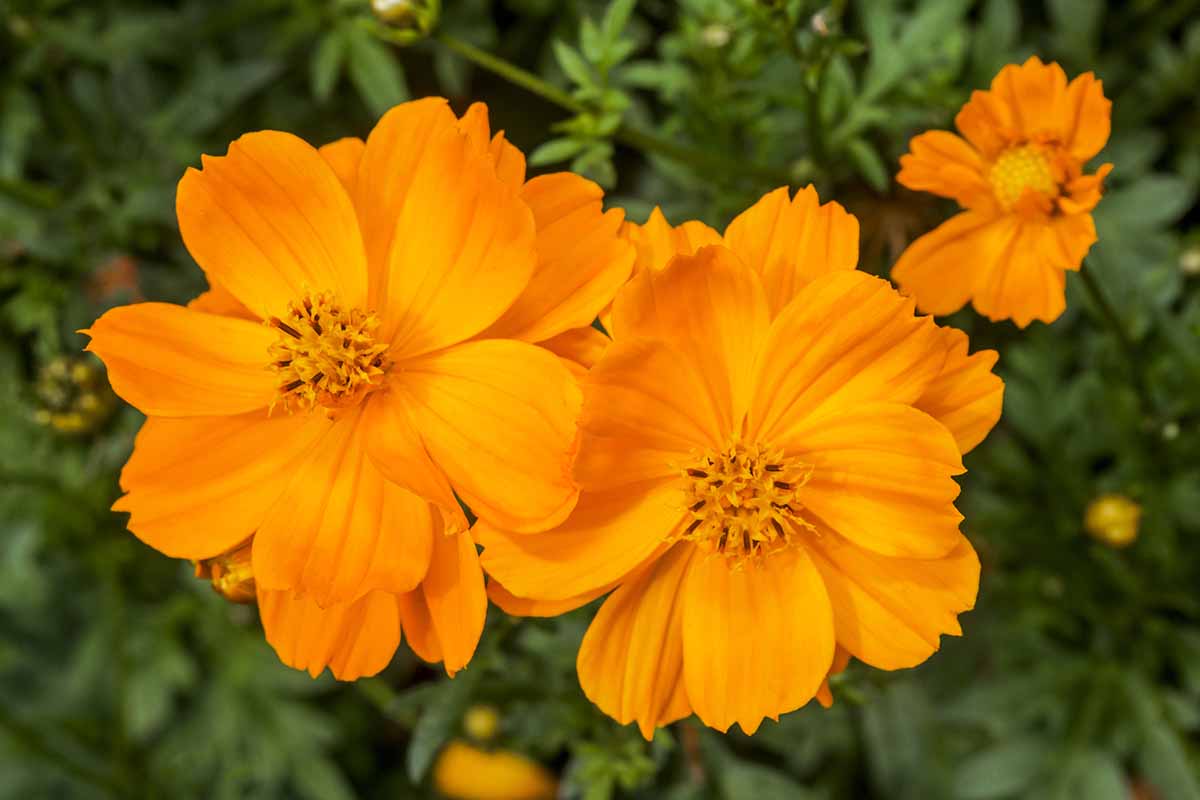
They have slightly different flavors, with the first tasting herbal and lettuce-like, while the second has a sweet, fruity flavor, not unlike a strawberry or mango.
In Indonesia where it is frequently consumed, C. caudatus is known as kenikir. In Malaysia it’s called ulam raja, which translates to “king’s salad.” Sounds about right to me.
Learn more about cosmos and how to grow them here.
20. Dahlia
The first time someone told me to eat a dahlia, Dahlia pinnata to be exact, I thought they were messing with me. No way could those big, dramatic blossoms taste like anything good.
As it turns out, I was right – but so was my friend. The species I tried wasn’t the best, but in the subsequent years, I’ve had some that were incredible.
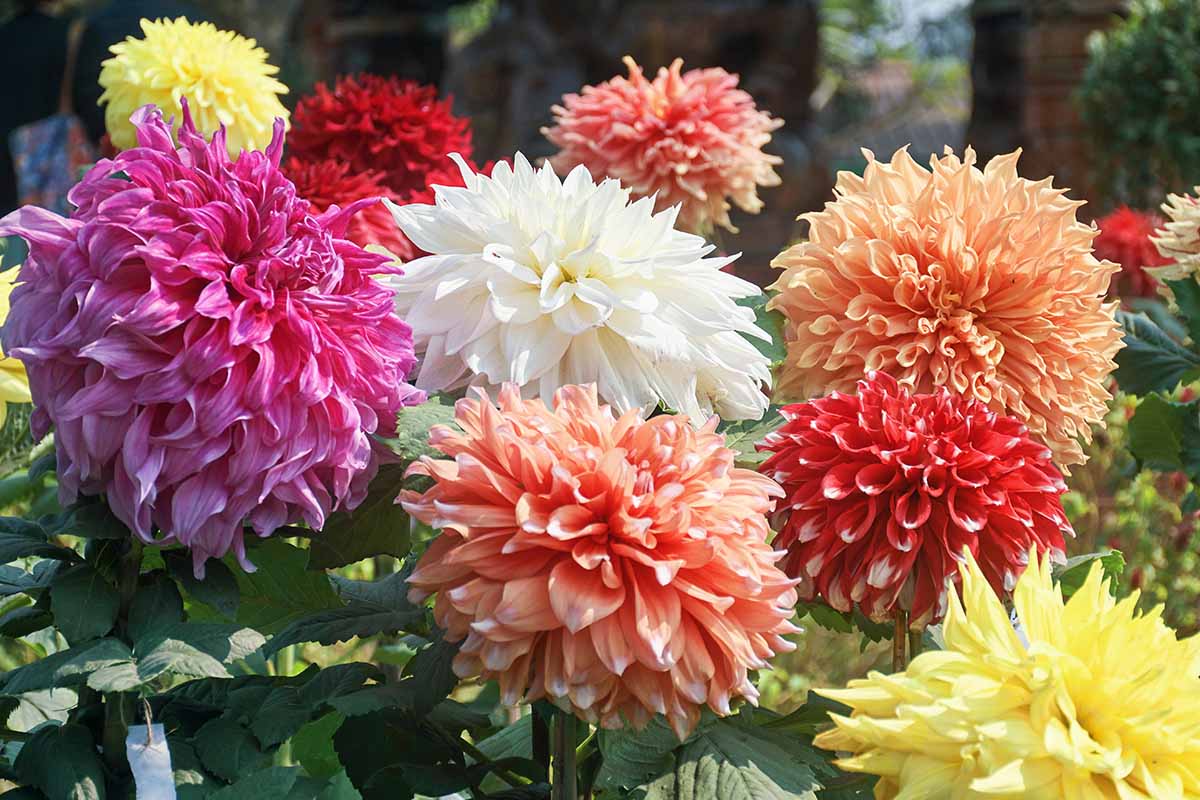
Dahlias are related to sunflowers and Jerusalem artichokes. All species are edible, and some of them have a fantastic flavor. They were cultivated in South America as a food crop long before they were bred into the beauties we know today.
Finding fabulous-tasting dahlias is a matter of trial and error. Some are marvelous and taste like a floral water chestnut.
Others are a bit more bland, but certainly not off-putting. My favorite to date is D. coccinea – I tasted the root and flower, and both were fantastic.
But don’t let that limit you. Any species of dahlia has the potential to produce a flavorful cultivar or hybrid. In fact, if you find one you love, spread the word! Let us know in the comments which variety is your top pick.
The crisp, fresh texture adds contrast to cheese plates and salads. They also make quite the statement as a colorful topper for fish or pasta dishes. Chop the petals into a salsa or use them to garnish a rice dish.
Our guide to growing dahlias provides cultivation instructions.
21. Daisy
These “everlasting beauties” – that’s what the common daisy’s botanical name of Bellis perennis means – can be eaten from the moment the buds emerge to the time when the petals start to wilt.
The buds are actually less bitter than the open flowers and they can be pickled just as you would dandelion buds to make “capers.”
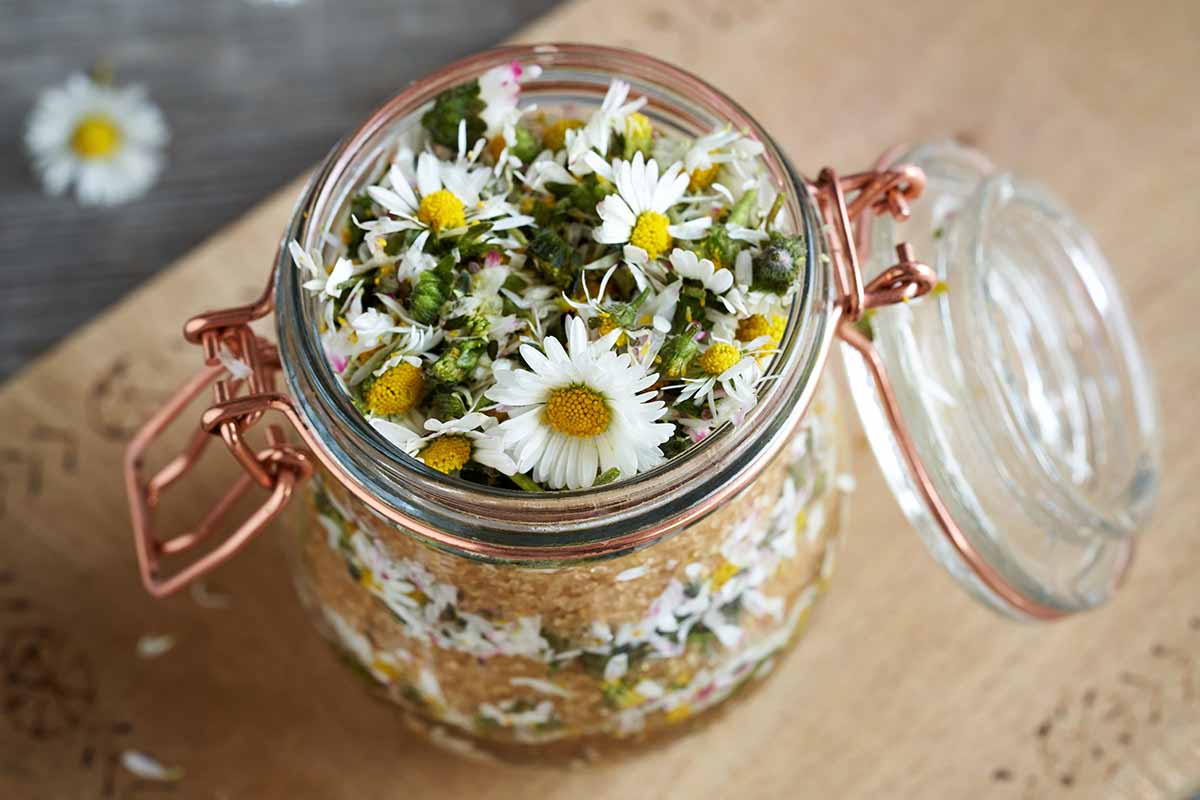
I like to toss the flowers on cottage cheese, spinach dip, and salads, but they’re also nice in compound butter or they can be candied.
Just be aware that lots of plants have been given the common moniker “daisy.”
Plants such as Shasta (Leucanthemum × superbum), Gerber (Gerbera spp.), and Montauk daisies (Nipponanthemum nipponicum) aren’t true daisies, and these are not edible.
22. Dandelion
The leaves tend to garner all the attention in the realm of edibility, but you should definitely give dandelion (Taraxacum spp.) blossoms a shot as well.
After you harvest them, soak them in cool or room temperature water for a few minutes to drive out any insects that might be hiding in the inflorescence.
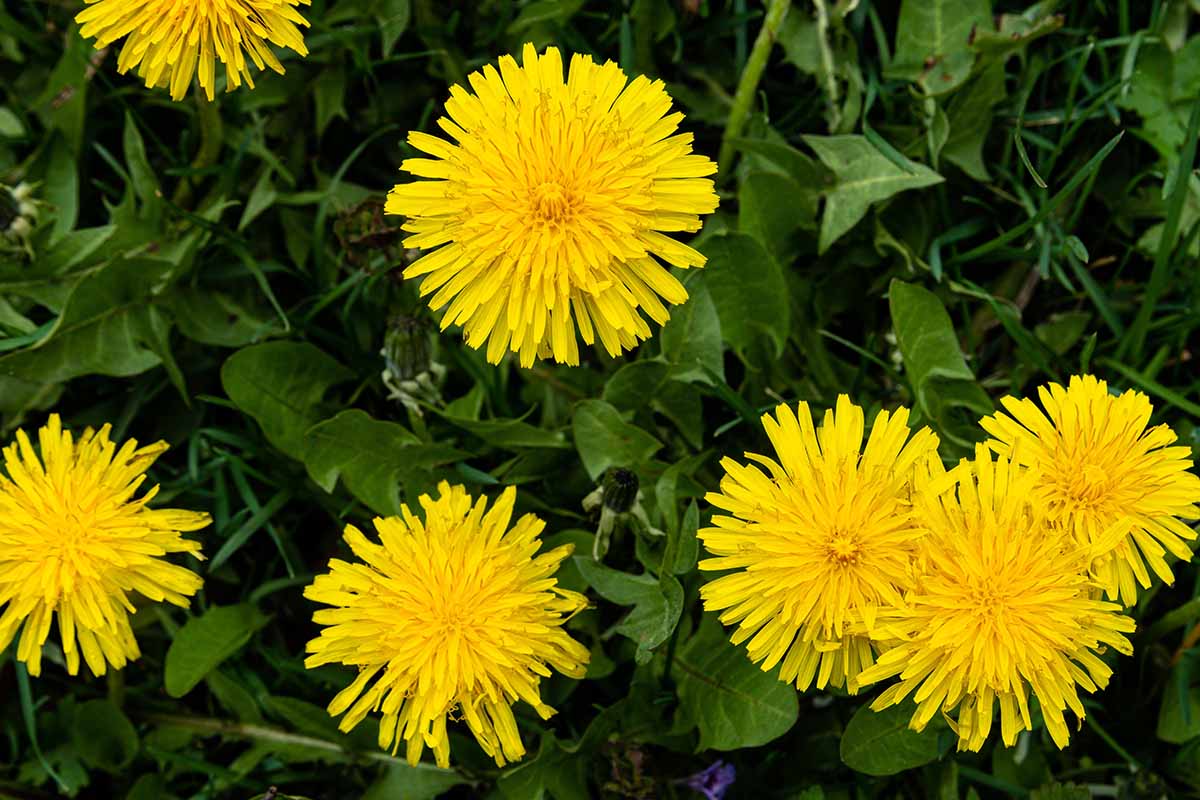
Dandelions are incredibly versatile. Pick the compact green buds and pickle them to make “capers.” Or toss the buds in salt, pepper, and butter, and saute them for a few minutes to make a treat that tastes similar to mushrooms.
The flowers can be used to make an infused dandelion syrup. After plucking the petals and washing them gently in cool water, bring a mixture of equal parts water and granulated sugar to a boil in a saucepan to dissolve the sugar and make a simple syrup.
Remove from heat, then add the petals, and steep while allowing the mixture to cool, either in the pot or transferred to a heat-safe metal or glass bowl.
Cover and allow to sit at room temperature for 24 hours. Strain and store in an air-tight jar or bottle in the refrigerator for up to 1 week.
You can also cook the flowers like spinach or toss them fresh on salads. I like to chop up larger flowers and remove the green bits to improve their sweetness. Smaller flowers can be used whole.
Of course, you can also make dandelion wine, chop the blooms for use on omelets, garnish soups, or make them into a tea.
23. Daylily
Daylilies (Hemerocallis spp.) are showy and make for an impressive display, but unlike some flowers that are technically edible but not very flavorful, they’re super tasty.
I think they’re good enough that it’s worth growing them as edibles. The display is just a bonus.
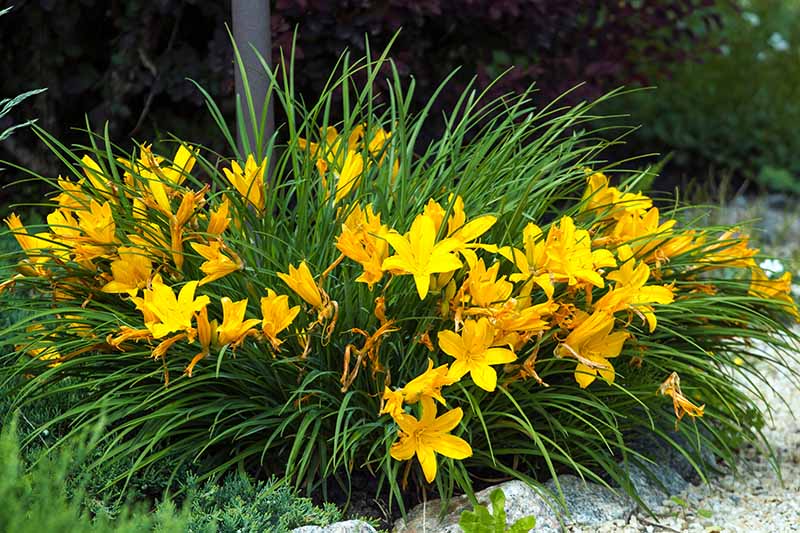
Pluck the flowers in the morning when they open. The petals taste like green beans with honey and a touch of black pepper added. Don’t eat the pistils and stamens. While they’re not poisonous, they have an unpleasant texture and flavor.
Pickle the succulent petals, use them as a topping for meat and fish, or chop and add them to eggs or salads. Stuff them or batter and fry them up as you would squash blossoms.
My mouth is watering just thinking about it… Just be sure to gently pull away the pistils and stamens first.
But don’t confuse daylilies with true lilies (Lilium spp.), which are poisonous! Look at the leaves to determine which is which.
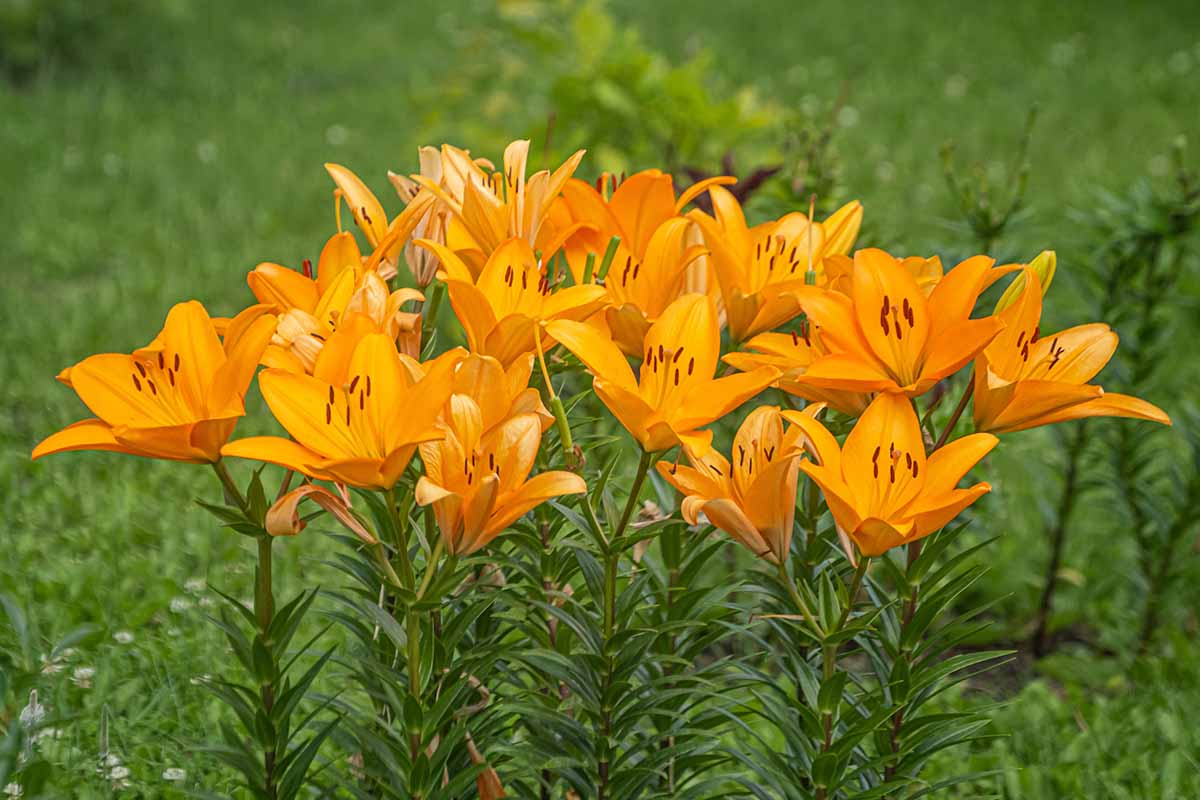
Daylilies have long, flat blades that emerge from the soil line. You’ll also find multiple stems on the plant. Lilies have a single stem with a spiral of leaves that travel up the stem.
Learn more about daylilies in our guide.
24. Elderflower
Whether you grow them for food, medicine, or ornamental use, those clusters of heavenly-smelling white elderflowers (Sambucus spp.) are a fabulously sweet treat. They taste like sweet grapes.
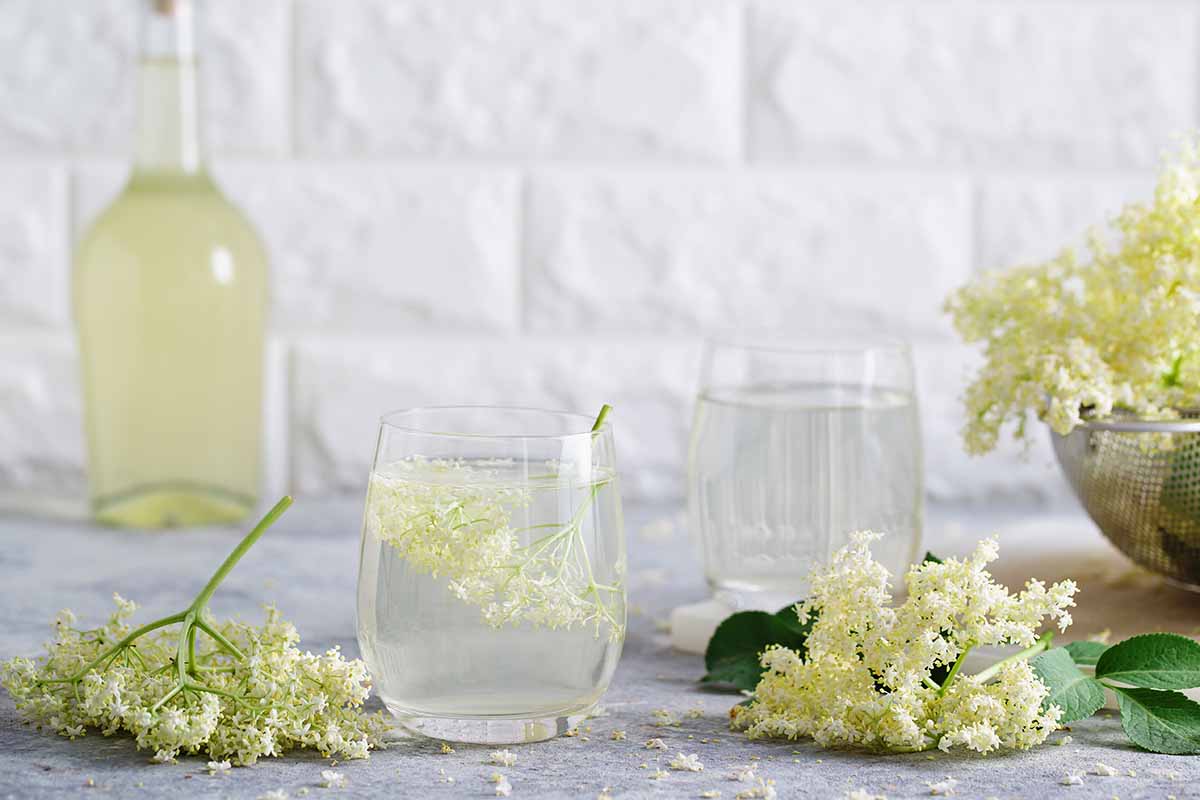
Obviously, they’re popularly made into wine, but you can also use them to top pancakes or fritters, batter and fry them, or use them as a garnish for duck or chicken.
You have to be careful about timing when harvesting the blossoms. If you wait too long, some of the flowers in each cluster will already be faded and brown, and they don’t taste good at all.
First, make sure all of the flowers are open. They mature starting from the outside and moving into the center.
Gently rinse them in cool water and allow them to dry before use. You’ll miss out on the berries when you pluck these, but the taste sensation is worth it.
Check out our guide to growing elderberries to learn more.
25. Evening Primrose
Sure, they’re famous for that medicinal oil, but evening primrose (Oenothera biennis) is entirely edible as well. Eat the buds raw or cooked and the petals raw. You can eat the seeds, too.
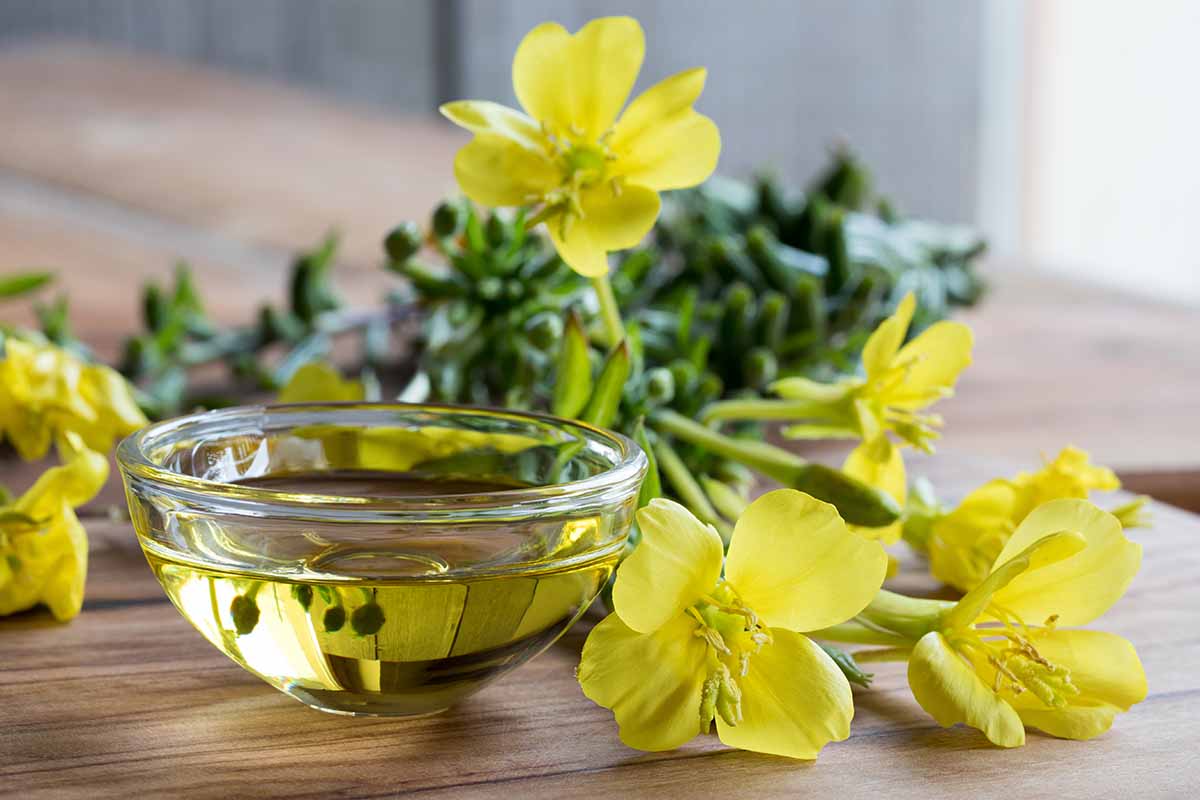
The petals have a citrusy, honey-like flavor that is best in sweet dishes like cookies, cakes, shortbread, and pavlovas.
If you want to grow evening primrose in your garden, check out our guide.
26. Forget-Me-Not
As sweet and petite as a mouse’s ear – which the genus name Myotis is Greek for – the petite blossoms of a forget-me-not (Myotis spp.) are too cute to be forgotten.
If you’ve been drinking the Forget-Me-Not Frappuccino from Starbucks, they taste nothing alike. The actual flowers have a slightly floral, bitter note.
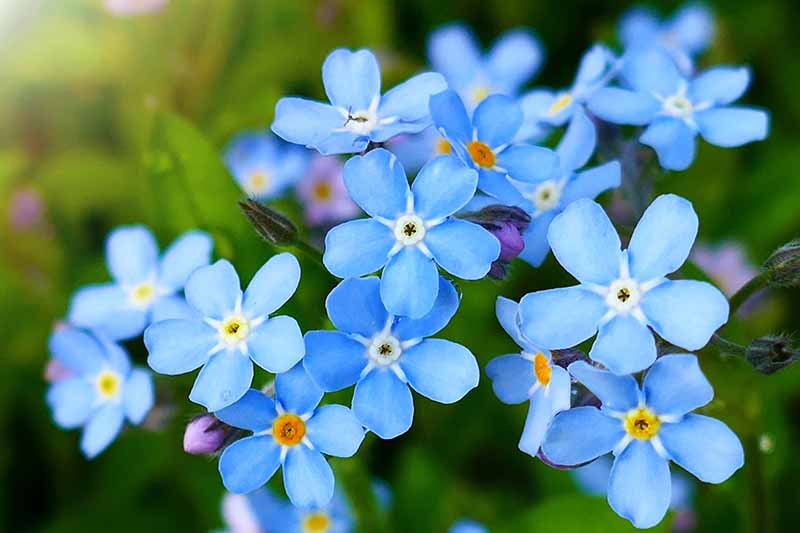
They’re best candied and used to top desserts, since sugar masks some of the bitterness.
Learn more about forget-me-nots in our growing guide.
27. Forsythia
Maybe you sigh in relief when spring arrives and the forsythia (Forsythia spp.) lights up the landscape. I know I do, since it means the dreary winter months are behind us. But those vibrant petals also herald the arrival of forsythia munching time!
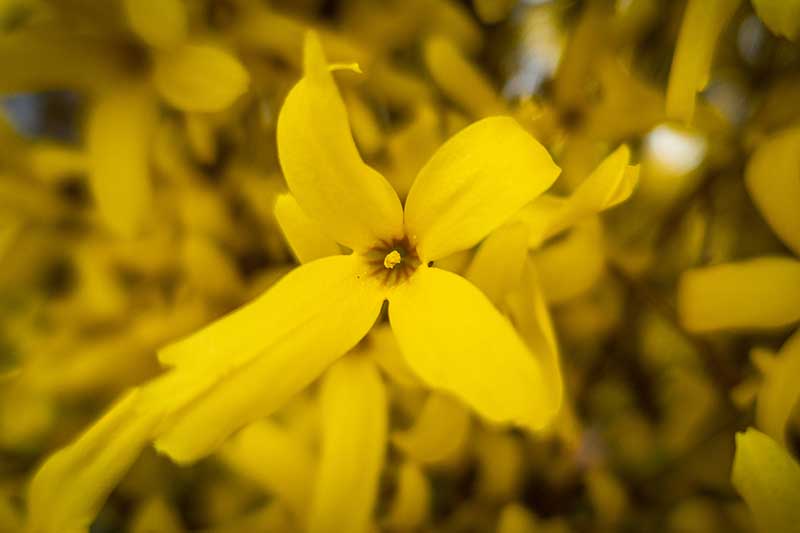
They have a mild floral taste that isn’t going to overpower anything, but the color is striking enough to make up for their mellow flavor.
Use them to make syrup, flavored honey, infused oil, jams, and jellies, or just toss them on a salad for added color.
Consult our guide to growing forsythia for cultivation instructions.
28. Fuchsia
Fuchsias (Fuchsia spp.) are some of the best flowers for eating, in my opinion. The berries are also fantastic. We even have a guide dedicated entirely to planting, harvesting, and dining on them, including the best varieties to try.
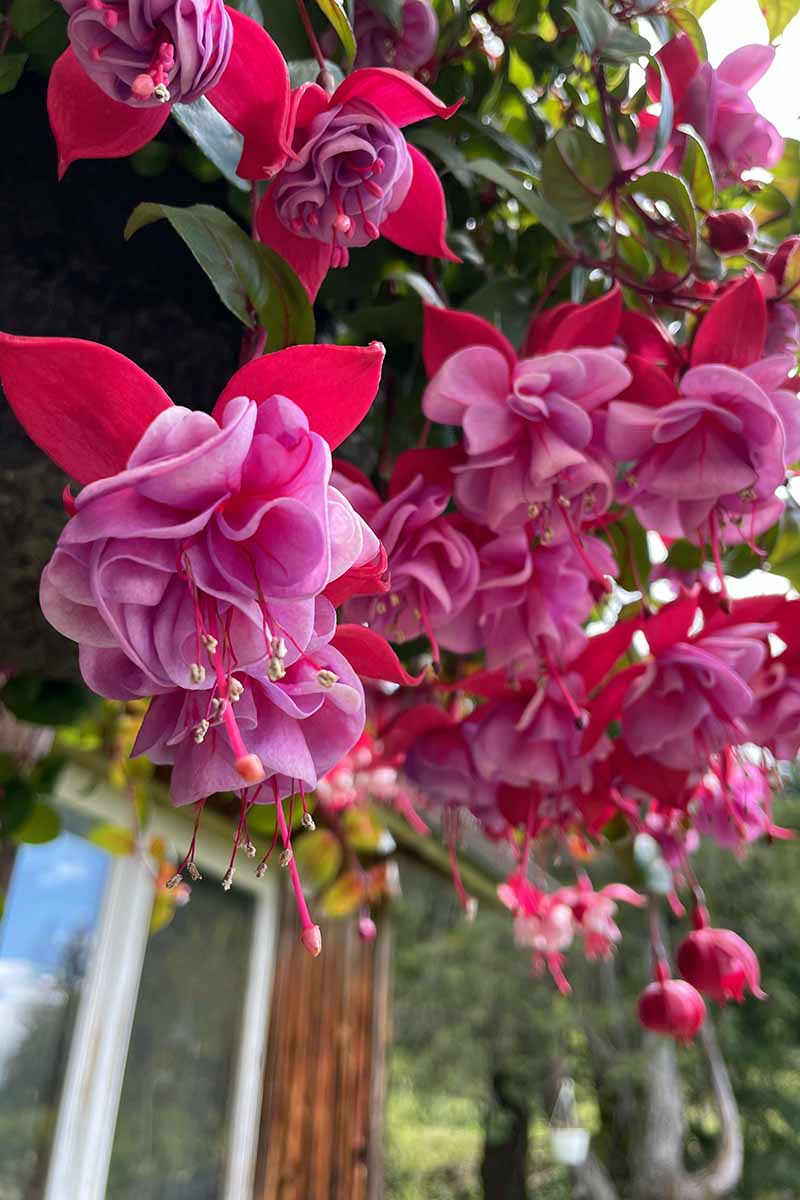
Some species have a better flavor than others, but they’re all edible and all taste good.
It’s hard to beat these flowers as a topping for a salad or soup, added just before serving, since they’re so stunning. Use them as an edible garnish for rice dishes or drinks as well.
29. Gardenia
Gorgeous gardenias (Gardenia spp.) smell like a tiny slice of heaven, and they taste just as good.
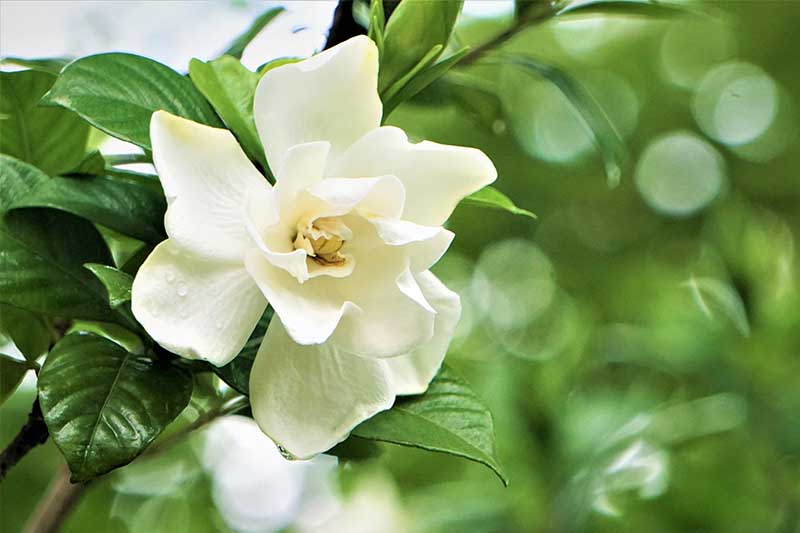
Once famous for use in corsages and wedding displays, the honey-sweet flowers can be pickled, candied, or battered and fried like fritters.
Use them to infuse honey, in ice cream, with whipped cream to top meringues, or you can even add them to stir-fries.
Learn more about growing gardenia in our guide.
30. Geranium
Scented geraniums (Pelargonium spp.) don’t taste quite as good as they smell, but it’s definitely worth experimenting to see which variety you like best.
Some of the flowers are better used as garnishes or to add aroma to your plate, while others are incredibly delicious.
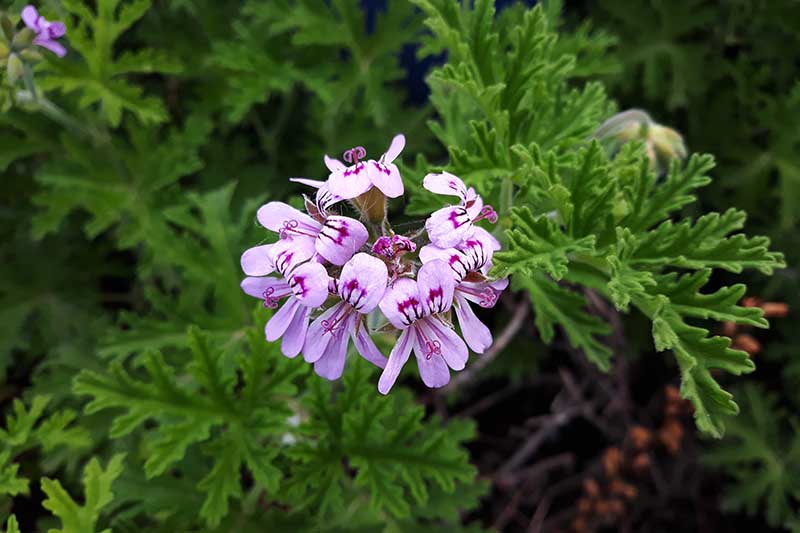
Citrus varieties are winners in fish and meat dishes, while the rose-scented cultivar is lovely in desserts.
Cranesbill geraniums (Geranium carolinianum) are also edible, from the roots to the flowers, but these aren’t nearly as tasty as their scented cousins.
The blossoms on zonal geraniums (P. x hortorum) are edible as well. But give them a taste before you commit to using them in a recipe, because the bitter flavor isn’t to everyone’s liking.
31. Gladiolus
Gladiolus (Gladiolus spp.) tastes a lot like romaine lettuce but these blossoms are a whole lot prettier in the garden.
This flavor profile makes them perfect for use in salads, but you could also toss them in lettuce soup or add them to sandwiches for some bold color.

Even better, stuff them as you would squash blossoms. Try shredded chicken, tuna, egg, cheese, or anything else that strikes your fancy.
Just imagine a plate full of orange, maroon, purple, and salmon-colored gladiolus being passed around as appetizers at a party. They’re impressive.
Be extra careful to wash these flowers gently because they can become crushed or ripped quite easily.
Learn more about growing gladiolus in our guide.
32. Hawthorn
These are my least favorite to harvest of all the blossoms on this list, thanks to the tree’s gnarly thorns, but hawthorn (Crataegus spp.) flowers are quite flavorful.

You should only eat the flower buds or the young, recently opened flowers, never the older blossoms that are turning brown.
And as just a brief aside on hawthorn fruit – don’t even think about eating the seeds inside the berries since they’re poisonous. The flesh of the berries, however, is fine to consume.
Young hawthorn flowers and buds have a similar flavor to crabapple blossoms, which are lightly floral.
Learn more about hawthorn care here.
33. Hibiscus
One of the few flowers that can stand up to cooking, Hawaiian hibiscus, also known as rose mallow or Hibiscus rosa-sinensis, has a tart flavor that is oh-so-refreshing. If you’ve ever had Jamaica tea then you know what I’m talking about.
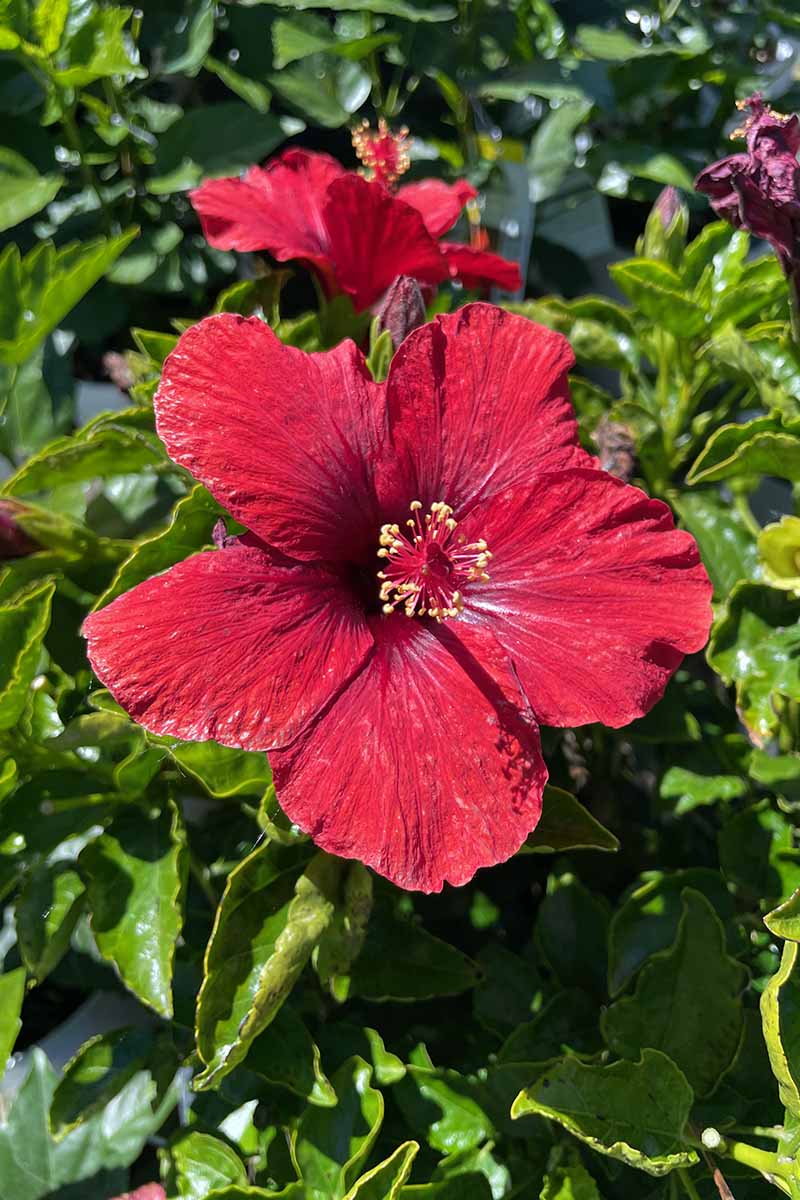
All perennial hibiscus species are edible, but H. rosa-sinensis and H. sabdariffa are the best tasting.
Cook them in quesadillas, enchiladas, or taquitos, toss them in salads and cocktails, bake them into tarts and pies, or make them into jam.
Our guides provide cultivation instructions for hardy hibiscus and tropical hibiscus.
34. Hollyhock
Hollyhocks (Alcea spp.) have been around for an extremely long time, and they’re one of the earliest recorded cultivated flowers. People in their native Asia and Europe munched on them and used them as ornamentals in the garden simultaneously.
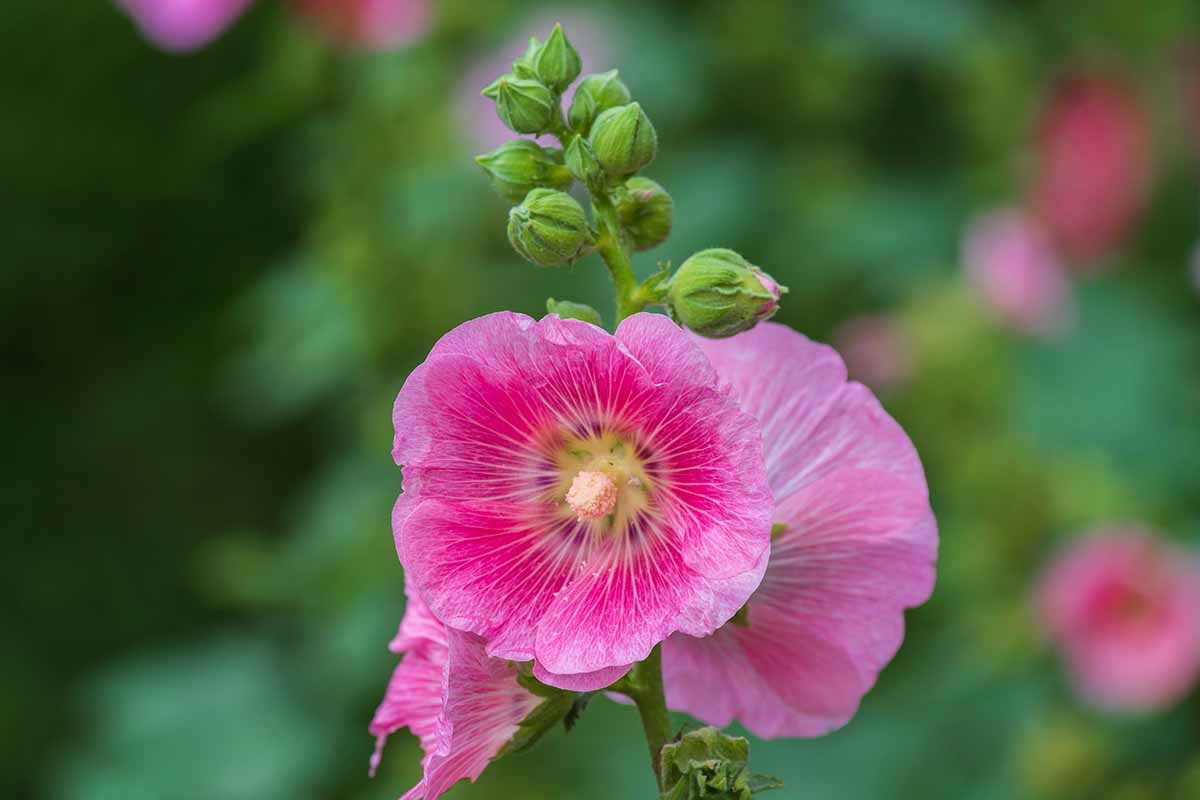
Remove the seedy center and use them on salads, in cocktails, on desserts, or to garnish a cheese plate.
Learn more about hollyhocks in our growing guide.
35. Honeysuckle
If you ever sucked on the ends of honeysuckle blossoms (Lonicera spp.) when you were a kid, then you know just what you’re in for.
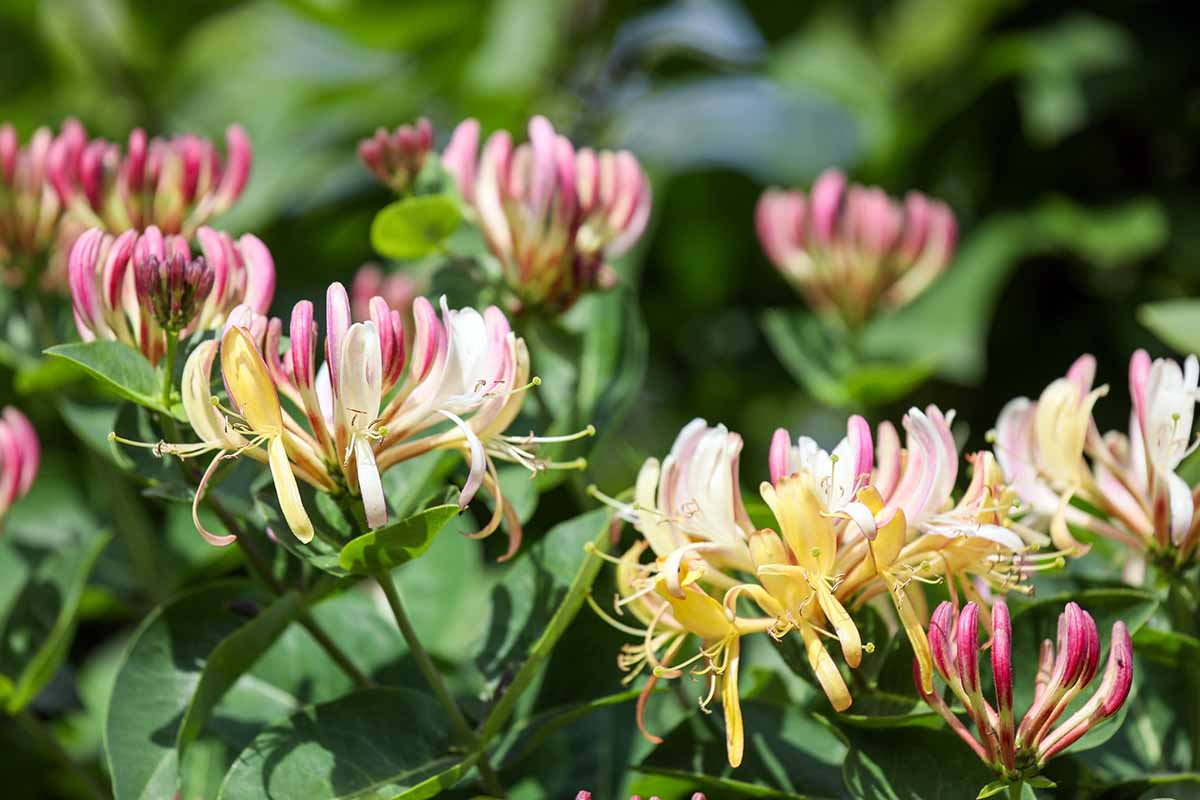
Honeysuckle is sweet, floral, and yes, similar to honey in flavor. The flowers are wonderful for infusing tea or honey, and tossed on desserts or into salads.
Consult our growing guide to learn how to cultivate honeysuckle.
36. Hosta
A lot of people don’t realize how beautiful hosta (Hosta spp.) flowers can be, and even more people don’t know that they’re edible – as are the young shoots of the plant.
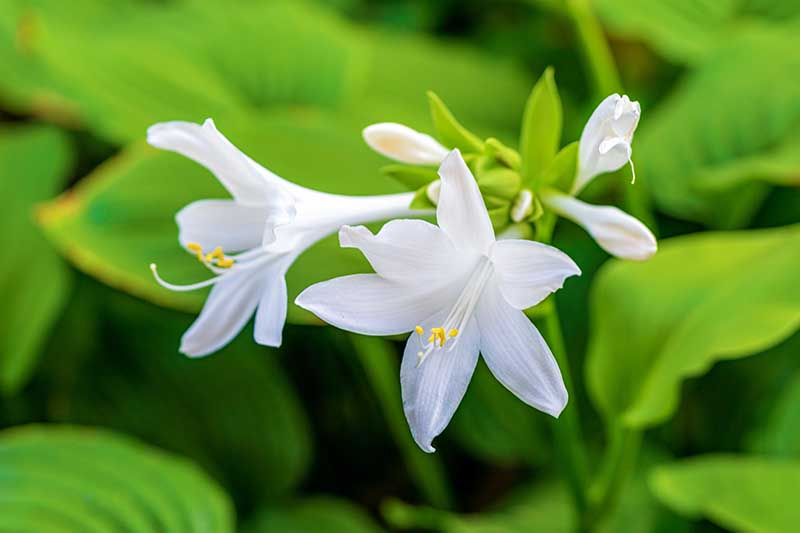
I wouldn’t say that they’re worth cultivating solely for the edible flowers, however, since they’re pretty mild. But they’re not at all bitter, and they have a subtly sweet, floral flavor.
Learn more about cultivating hostas here.
37. Impatiens
Impatiens walleriana are a standard in shady garden spots, but they should also be more popular in the kitchen. Flowers of this species are most commonly referred to simply as impatiens, or sometimes as busy Lizzies.

The petals are surprisingly sweet and crisp. They’re just perfect for cocktails, desserts, salads, and sandwiches.
Don’t eat any other Impatiens species. Some, like jewelweed, are edible but should only be consumed if they’ve been cooked. It’s easier to just stick with the good old garden classic we know and love for this genus.
Learn about how to grow impatiens here.
38. Jasmine
There are lots of different types of jasmine out there but only Arabian jasmine (Jasminum sambac) is edible. Every other species is poisonous, so you have to be absolutely, 100 percent sure that you’ve got the right one.
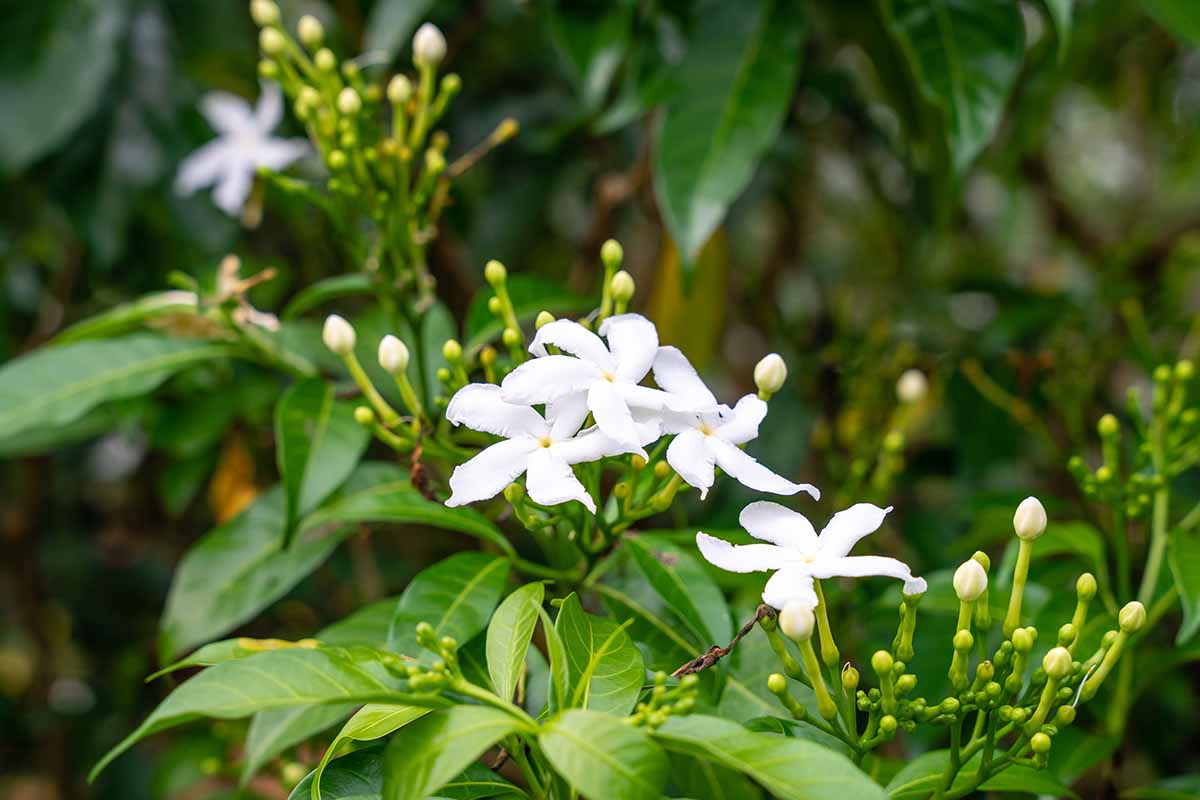
So long as you have the correct plant, you can enjoy the pungent blossoms sparingly as a garnish, or in syrups or cocktails. The flowers are pungent and they can overpower your senses.
39. Lavender
I’ll warn you in advance, lavender (Lavandula spp.) should also be used sparingly. It isn’t bad for you, but the flavor is bold.
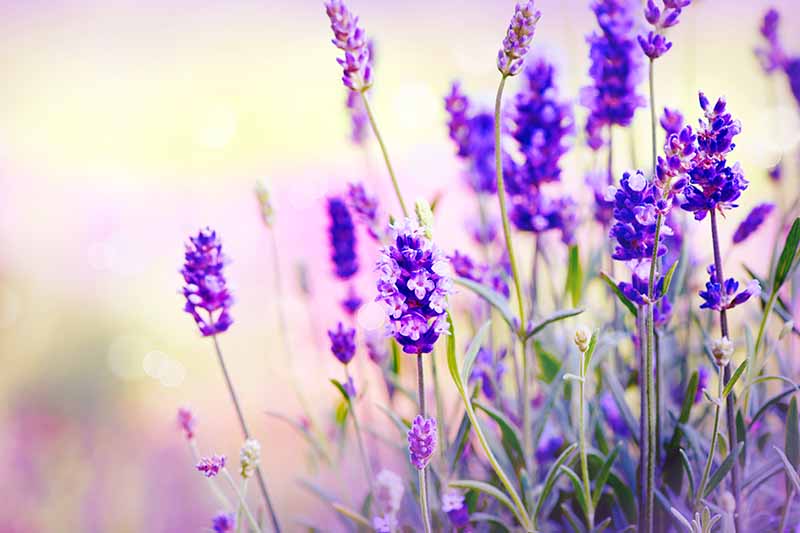
You know that pungently floral, spicy fragrance of the flowers? They taste just like that. That’s why so many people prefer them candied, since the sweetness cuts down on the spice.
Lavender tea is marvelous, and as many people already know, the candied flowers are an edible floral staple.
But be a little more creative! Use lavender in cocktails, fruit salads, and on desserts, to make jams and jellies, or in pies.
Then, try the blooms rubbed onto beef as part of a spice blend, chopped finely and added to a sauce for lamb, or tucked in around a roasted chicken before serving.
Our guide to growing lavender provides full cultivation instructions.
40. Lemon Verbena
You already know that you can eat the leaves of lemon verbena (Aloysia citradora), but the blossoms taste just as good, if not better.
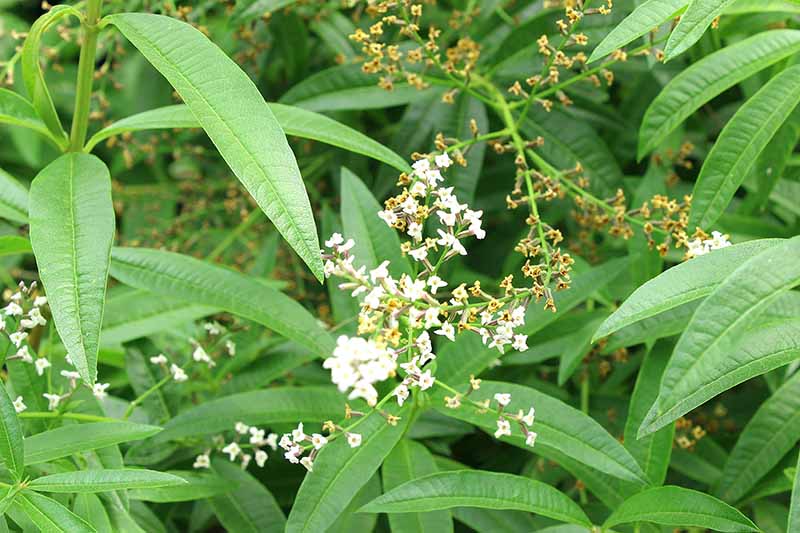
They have a similar flavor with an added floral hint. Use them liberally in cocktails and desserts.
Learn more about lemon verbena here.
41. Lilac
Lilacs (Syringa spp.) taste just like they smell: pungently floral and sweet.
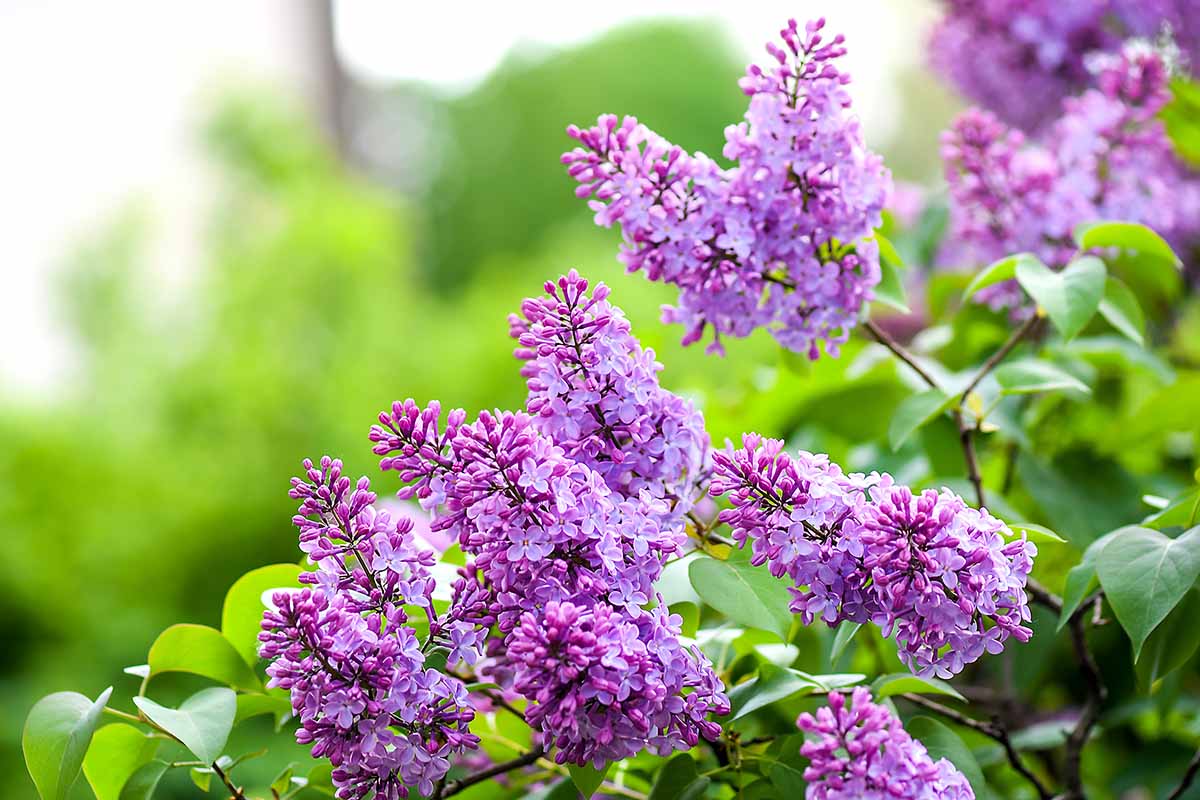
Every spring, I stuff lilac blossoms into a mix of equal parts sugar and water, and cover it with a cotton cloth. Then, I agitate the mixture every day for a few days. Next, I strain the liquid and seal it with a lid.
After a few days, the yeast on the flowers causes the liquid to ferment. Voila, you have a naturally fizzy drink with a marvelous flavor!
You can also candy these flowers or use them on desserts.
Learn more about lilacs in our growing guide.
42. Linden
Gardeners seem to have a love-hate relationship with linden trees (Tilia spp.). They can be messy, but my goodness, the flowers smell incredible! And you can eat them, too.
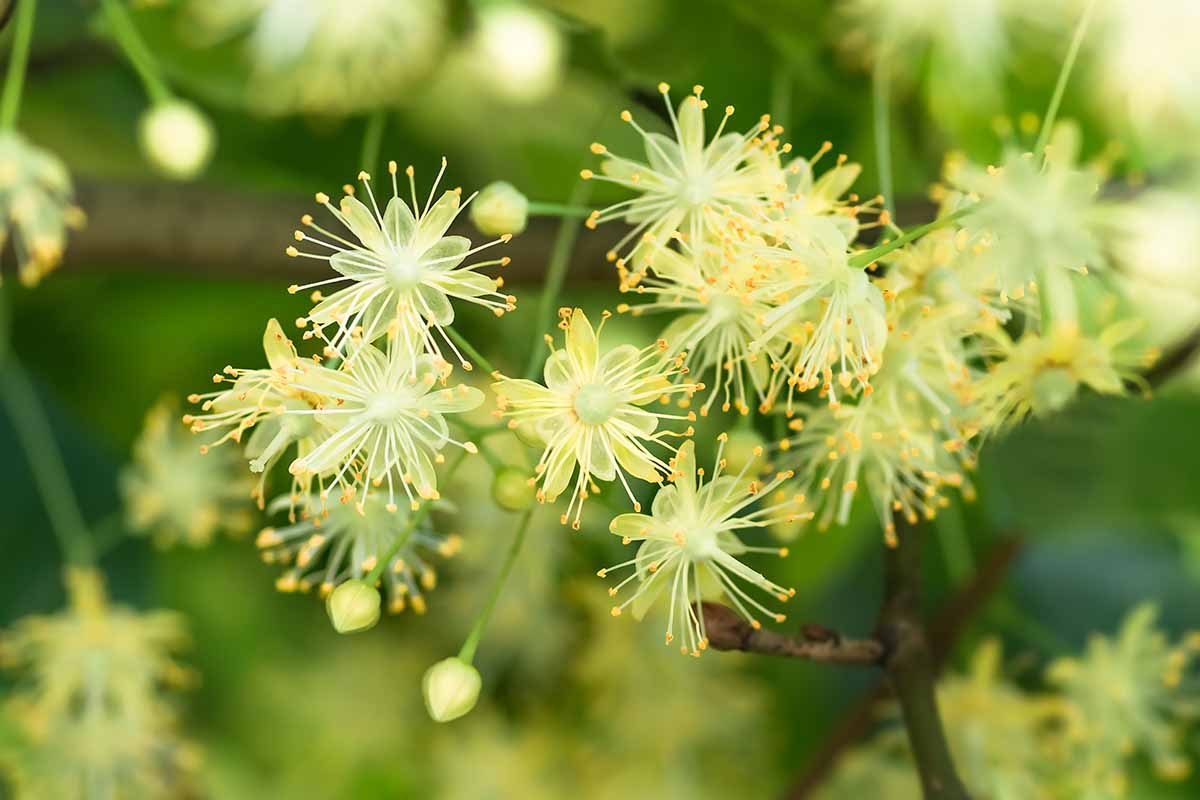
Gather them soon after they open, before they start to turn brown. Use them to garnish desserts or cocktails.
43. Lotus and Water Lily
These close relatives look and taste very similar. Many people eat the roots of lotuses (Nelumbo spp.) and water lilies (Nymphaeaceae family), but the flowers are edible as well.

Remove the sepals and stamen and then stuff the honeydew-flavored flower with anything your heart desires, like cream cheese, dip, or pickled veggies.
You can batter and fry them, chop them to add to soups and salads, or just use them as a garnish.
44. Magnolia
Magnolia blossoms (Magnolia spp.) are edible, but there’s a lot of debate about which type tastes best. Some people swear the ones with pink petals are the way to go, while others say the magenta and white ones are superior.

I say, just take a nibble of whatever you have access to and decide if it’s for you or not.
The darker the color, the more bitter the flavor becomes. White is more citrusy, and pink has hints of cardamom.
The petals are excellent pickled and can be used to replace pickled ginger, since the blossoms also have a ginger-like flavor.
45. Mallow
Mallow (Malva spp.) is a unique addition to the kitchen in that we don’t usually eat these plants for their flavor, but for the texture they provide. You can add the mucilaginous leaves to soups as a thickener.
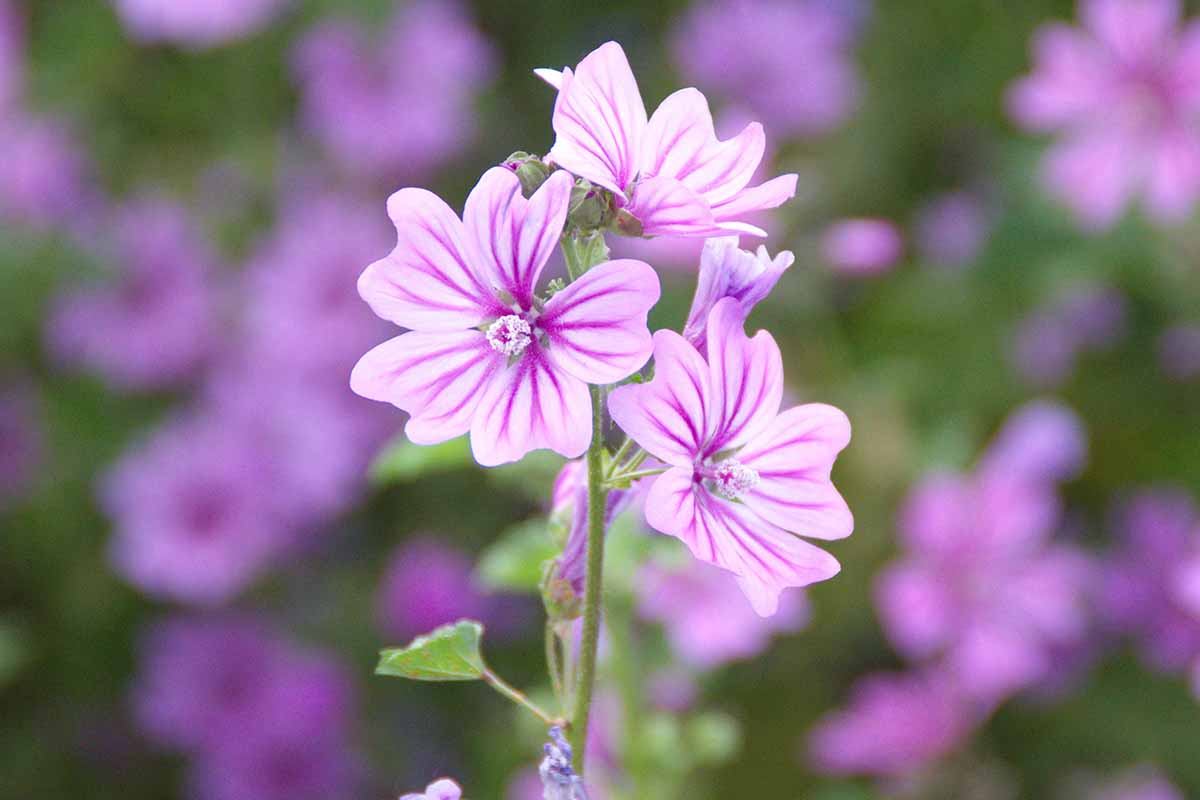
The petals are also flavorful either cooked or raw, but test out the texture first before you go all in.
The viscous mouthfeel can be off-putting to some people, but the mild flavor makes this flower ideal when you want something similar to tofu that will absorb any flavor you pair with it.
Use it anywhere you would use okra, in soups, salads, or stir-fries.
46. Marigolds
Of all the species on this list, marigolds (Tagetes spp.) might be the most versatile. The petals are perfect in breads, rice, stews, soups, cakes, and drinks, as well as egg, fish, chicken, beef, or veggie dishes.

They can be pickled with vegetables, added to compound butter, and used to garnish cocktails. And don’t forget their appeal in sandwiches, fish salads, and custards!
The dried leaves can also be used as a saffron substitute to add color to cooked dishes.
We have a whole guide available to help you use and enjoy these classic beauties.
And to learn how to grow marigolds, check out our guide.
47. Mint
We all know that mint leaves (Mentha spp.) are incredible, but how often do we actually eat the flowers?

Not often enough, I say! Use them anywhere you’d use mint. They have a similar flavor with a hint of floral goodness that I think makes them taste even better than the famous leaves.
They’re a bit of a pain to prepare since you have to carefully pop each flower off of the stem individually, but once you have a small handful, you have a game-changing ingredient available to garnish drinks, desserts, salads, and soup.
Seriously, try a palmful on a bowl of cucumber and milk or yogurt soup and tell me it didn’t blow your mind. Our sister site Foodal has a recipe worth checking out.
You always read in gardening guides about how you should trim any flowers off of your mint plants, but I say save them and put them to work in the kitchen!
Learn more about growing mint in your herb garden here.
48. Nasturtium
If watercress and honey had a baby, it would be nasturtium (Tropaeolum spp.). And that’s not a surprise, given that this plant was once considered a type of cress until Linnaeus reclassified it in the eighteenth century.
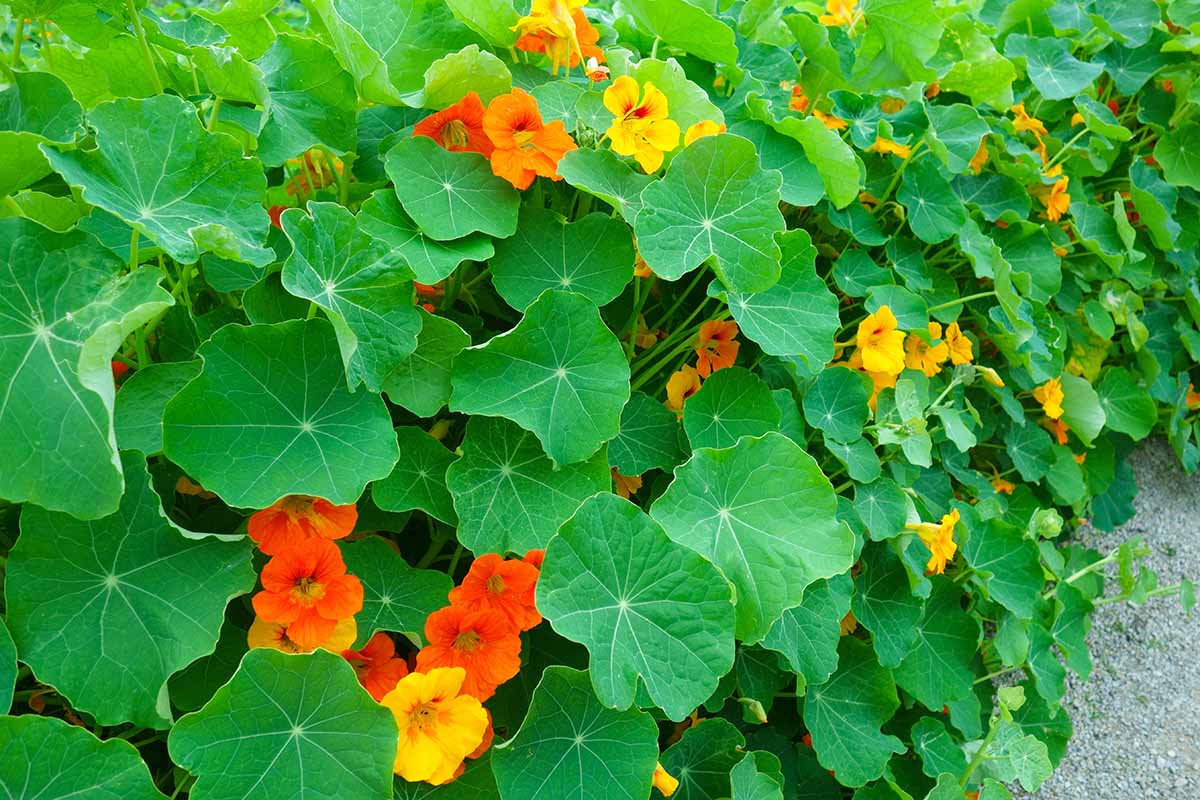
These flowers should be eaten fresh, and they don’t dry well. They also don’t cook well and taste bitter once they start to wilt.
For that reason, add them to warm dishes like omelets, quiche, fish, veggies, and soups immediately before serving. Otherwise, use them in cool dishes like salads, sandwiches, and desserts.
Broccoli and brussels sprouts become much more interesting when drizzled with melted butter infused with nasturtium blossoms. Add the blossoms to the jar when pickling veggies, use them as tiny lettuce-like wraps, or make a pesto.
Find more ideas and tips in our guide to eating nasturtiums, and if you need growing info, you can find it here.
49. Orchid
Orchids can be a little hit and miss when it comes to edibility, and there are many varieties out there. But if you stick with Dendrobium species, you’ll be in good shape.
These are the ones you can often find packaged at stores and sold for use in cooking. The flowers are firm and crisp with a flavor similar to endive.

They’re a hit battered and fried, but they’re also lovely in cocktails, in salads, or dipped in sugar for a sweet treat.
Want to learn more about orchids? Our guide has you covered.
50. Pansy
Most pansies (Viola tricolor var. hortensis) don’t have much flavor on their own. They’re best candied, or simply used as eye candy.
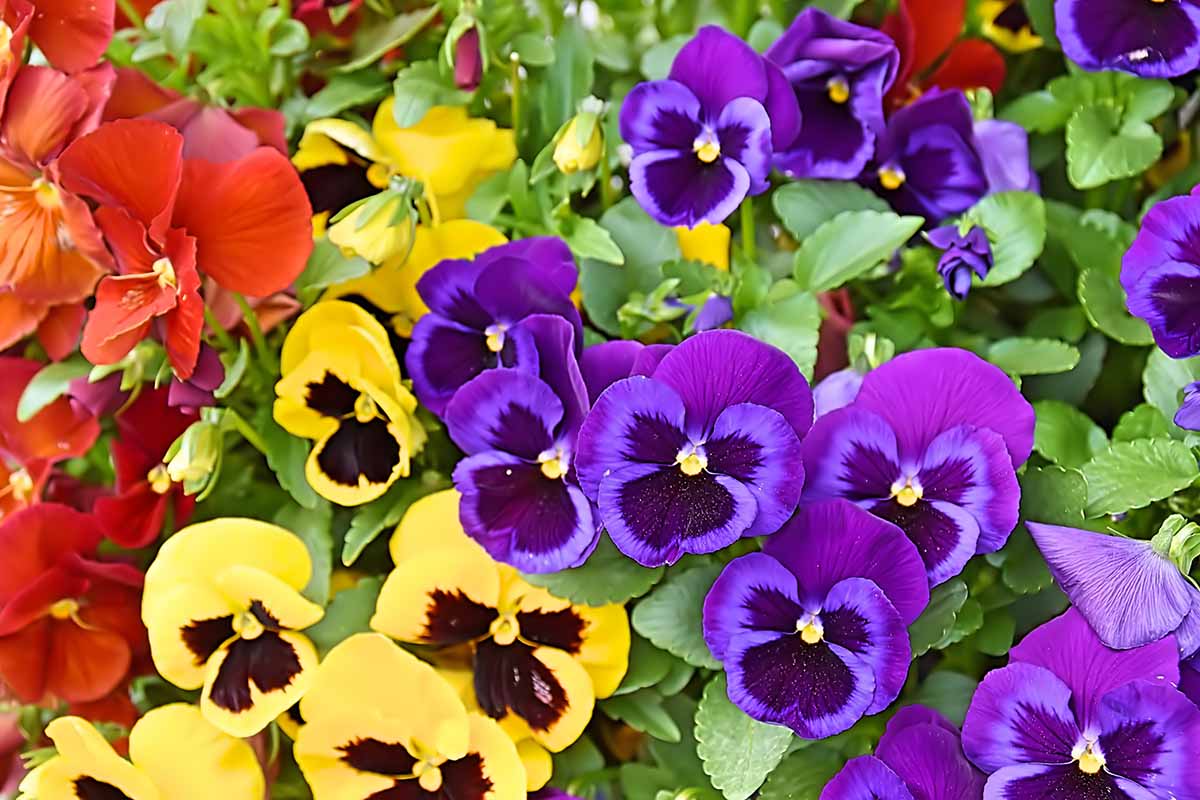
I think this is a shame, because they used to be much more flavorful than they are now.
Breeders have been focused on making prettier blossoms rather than tastier ones, but don’t let that stop you from using them in your desserts or salads if more for the color than anything else.
Though it’s mostly concentrated in the edible leaves and stems, if you hunt down Viola x wittrockiana, this hybrid still has the wintergreen flavor that makes violas real winners as edible blossoms.
It comes from methyl salicylate in the plant. If you pull the petals and just use them, they’ll have more of a mild, grassy flavor.
You can learn how to grow pansies here.
51. Passionflower
Passionflowers (Passiflora spp.) are so funky and alien-looking that you might be a little nervous to chomp down on one, but don’t be timid. The petals have a tart, sweet flavor and are beloved in tea, both iced and hot.
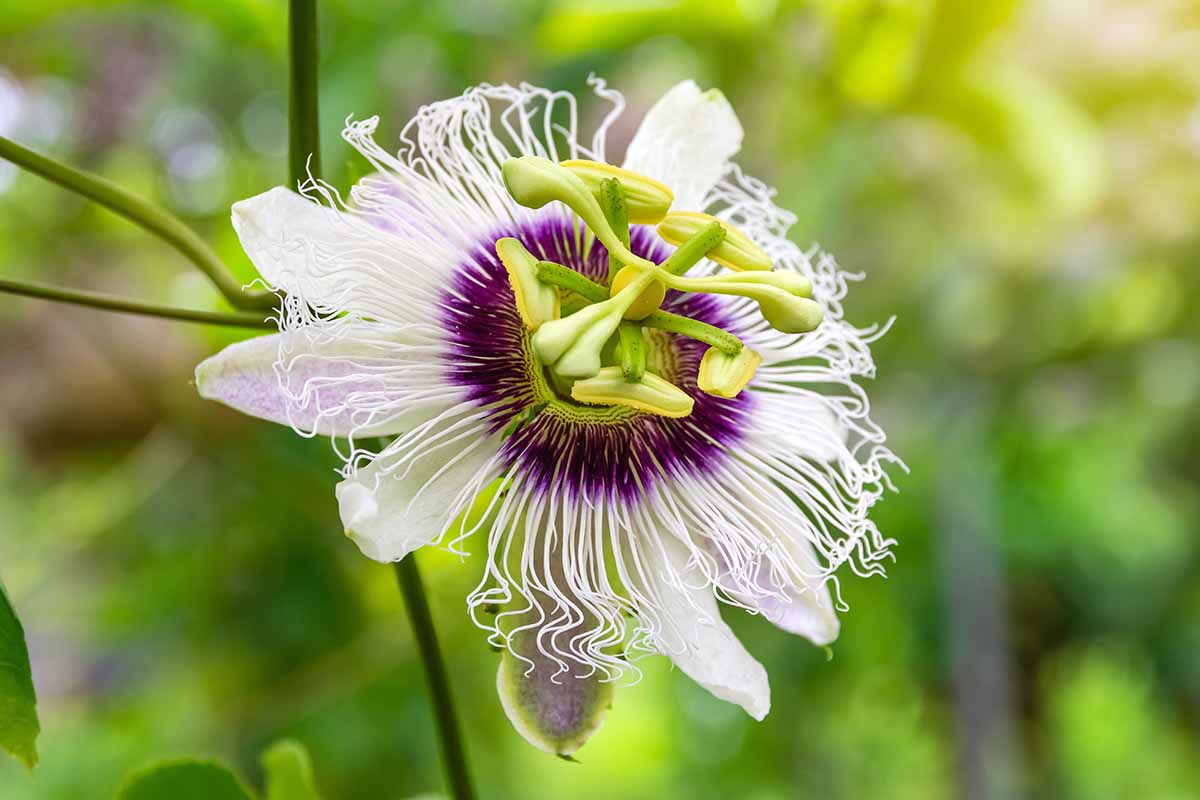
You can also use the petals to make a cordial as described above for lilacs, or chop them to use on desserts.
Learn how to grow passionflower in our guide.
52. Peas and Beans
Flowers from any type of edible pea plant (Pisum sativum) can be consumed, as well as some types of ornamental peas like blue butterfly (Clitoria ternatea).
True pea flowers taste a lot like… wait for it… peas! Blue butterfly pea has a distinctly chamomile-like flavor.
Blue butterfly blossoms are intensely blue, but if you mix them with an acid like lemon or vinegar, they turn the solution purple. You can use it to color or add flavor to dishes or cocktails.
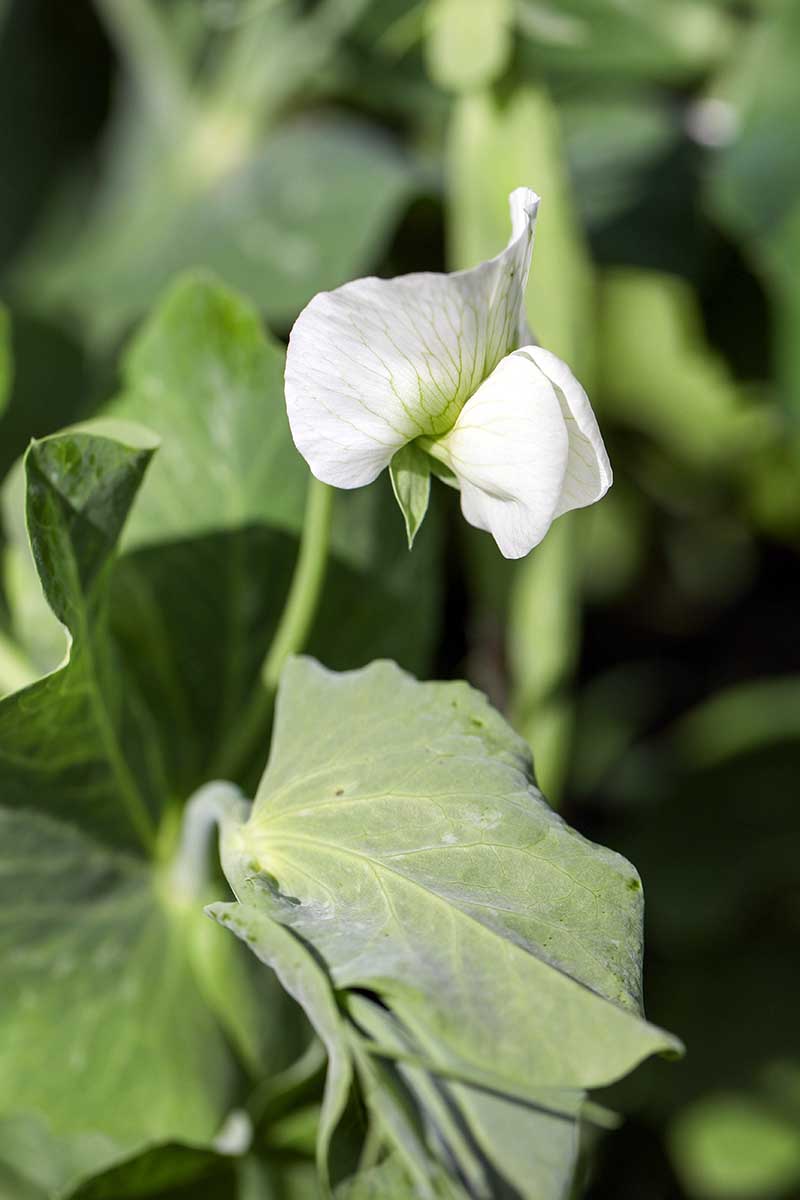
Toss true pea blossoms into any dish that you’d use peas in, from stir-fries and soups to salads and sandwiches.
Similarly, bean and some other types of legume flowers from the Phaseolus, Lens, Cicer, and Glycine genera have a distinctly beany flavor.
I think Great Northern and lima bean flowers are particularly delicious, and beans produce blooms in a variety of colors from white to pink to red to purple.
Don’t eat ornamental bean or pea flowers like sweet peas (Lathyrus odoratus) – the blooms as well as the pods and seeds produced by these plants are poisonous. Mung beans in the Vigna genus should also be avoided.
53. Peony
If peonies (Paeonia spp.) merely looked lovely, they’d still be well worth growing in the garden. But they also happen to be edible and they’re delicious. Depending on the variety, they may have a sweet, fruity, or slightly spicy flavor.

You can cook them, though they’re better blanched rather than thoroughly cooked, and they may also be consumed raw. Sweeter types are best in desserts and cocktails, while spicier types are fantastic in salads and tossed as a garnish on soups.
Check out our guide to learn how to grow peonies.
54. Phlox
Don’t confuse the edible variety here with creeping phlox. Only the tall perennial species also known as garden phlox or fall phlox (Phlox paniculata) is edible.
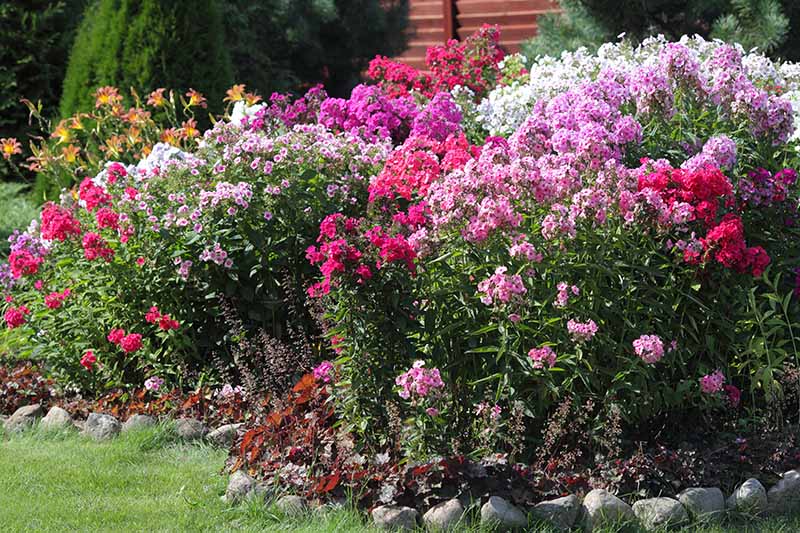
The flowers are sweet with a spicy bite and they are best used fresh in salads or on sandwiches.
55. Pommes and Stone Fruits
Crabapple and apple (Malus spp.), pear (Pyrus spp.), peach, cherry, and plum (Prunus spp.), you name it. They’re all edible and most of their blooms taste great.

Apples are the most cherished because they have the sweetest, most floral flavor, reminiscent of honeysuckle.
And quince (Cydonia oblonga) blossoms taste nothing like the cooked fruits you may have tried. They’re tart and astringent, like the raw fruits, but still delicious.
Reserve flowers from these types of fruit trees and shrubs for sweet dishes such as fruit salads, desserts, and candying. Make sure to trim away any woody bits, the calyx, and the stamens. You only want to use the petals.
56. Primrose
Welcoming the spring with their cheery blossoms, primroses (Primula vulgaris) are famously fragrant and decorative, but it’s still kind of a secret that they’re also delicious.

Some have a pleasantly mild flavor, similar to spinach. Others have a touch more bitterness and spice, sort of like arugula.
They can be used either raw or cooked in savory and sweet recipes. I think their pale yellow coloring makes them ideal as a salad or soup garnish or to top rice dishes. You’ll also see some varieties in white or pink.
57. Rose
The hips are popular in cosmetics or for making tea and who hasn’t enjoyed catching a whiff of a rose-scented perfume, candle, or lotion?
We know roses (Rosa spp.) are pretty and they smell good, but we should really be chowing down on those petals more often. Depending on the type, they’re usually delicious!
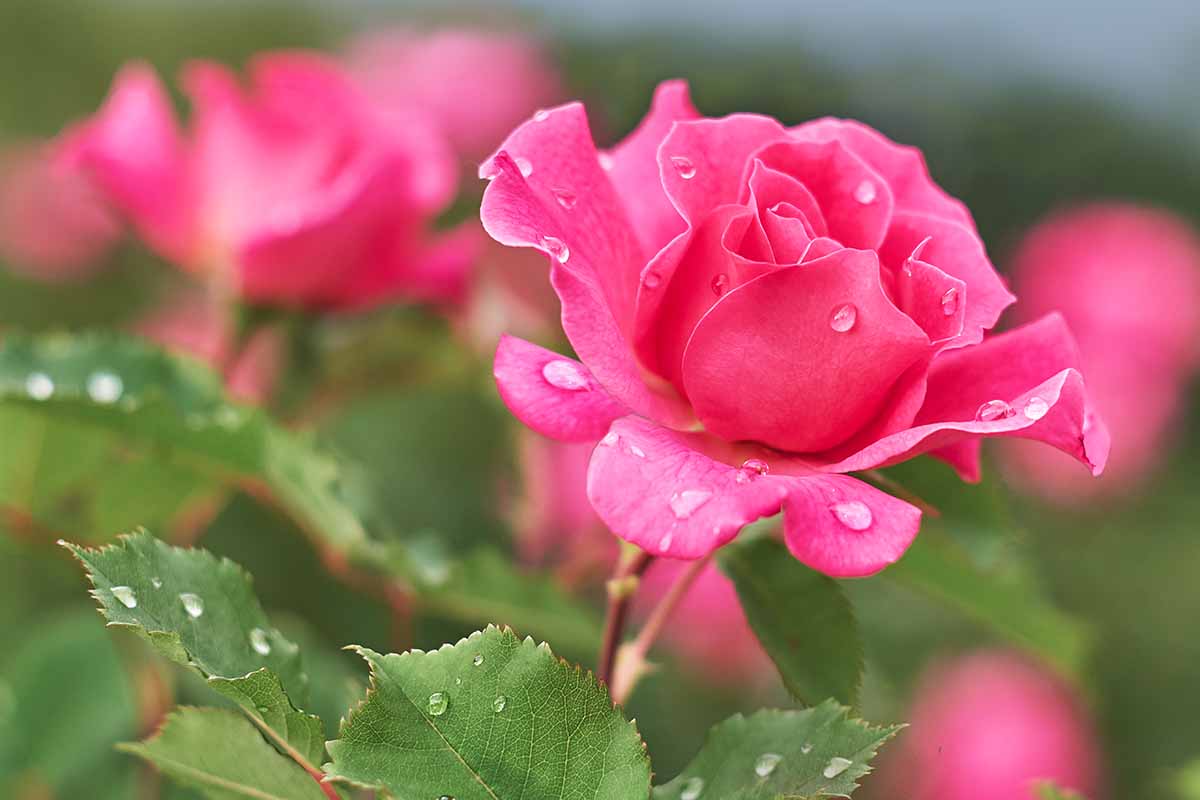
Rose water, rose syrup, and rose tea are pretty well-known options. But you can also make rose vinegar, compound butter, jellies, and jams.
Or toss the petals in cocktails, chicken or fish dishes, lamb curry, sandwiches, custards, cookies, cakes, and pies. You can even pickle them with or without other veggies, and you can dry them to use like any other herb in your cooking.
Want to try a heavenly treat? Try the rosewater cardamom lassi recipe from our sister site Foodal.
Before you start eating your way through the rose garden, give the rose you’ve set your eyes on a sniff. If you don’t like the scent, you probably won’t like the flavor – our senses of smell and taste are totally intertwined.
This applies especially to musk-scented roses in particular. Some people just can’t stand them.
The more fragrant the rose, the stronger the flavor will be. Darker ones and older varieties tend to be more flavorful. With the exception of David Austin roses, newer creations like Knock Outs and Drifts tend to have no flavor at all.
Wash the roses by rinsing them under a gentle stream of cool water or swishing them in a bowl of cool water, and then pull the petals off with your fingers, leaving the calyx behind.
Snip off the white heels and let the petals dry completely on a clean towel before use.
Learn more about growing roses in our guide.
58. Rosemary
Rosemary (Salvia rosmarinus) flowers add a spicy, resinous flavor that is slightly more subtle than the leaves to dishes.
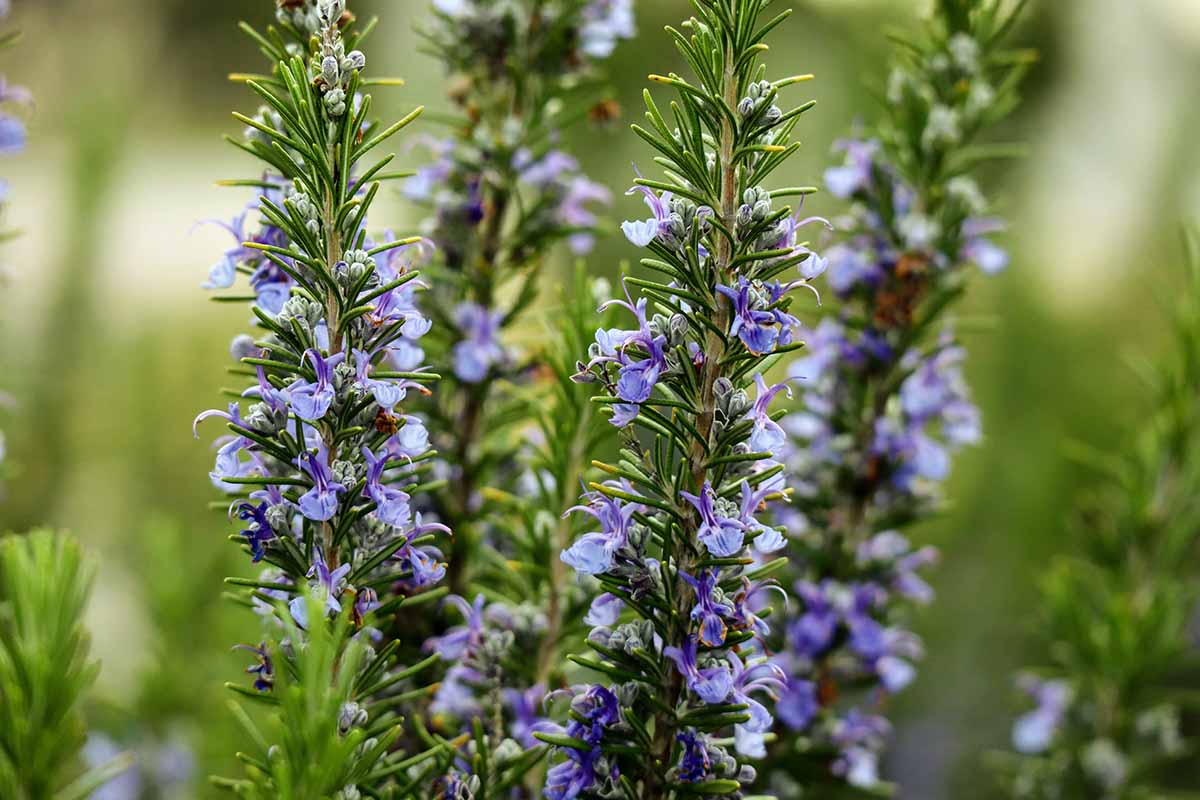
You can candy them for a pungently sweet bite or use them fresh anywhere you’d use rosemary.
In fact, I have friends that don’t like rosemary (I know, I’m not sure how we remain friends), but they love the flowers. They‘re just mild and different enough that their taste might win some people over.
You can learn how to grow rosemary here.
59. Snapdragon
Yep, this adorable cottage garden favorite (Antirrhinum spp.) is edible. Snapdragons can be a touch bitter, but don’t let that turn you off. Radicchio is bitter and it’s a gourmet staple!

If you haven’t checked out our guide to snapdragon edibility, read it now. And you will find cultivation instructions here.
60. Squash and Other Cucurbits
Most of us have had stuffed squash blossoms before, or we’re at least familiar with them already. You can also batter and fry them, add them to soup, salad, or egg dishes, or even use them to top chicken or pork.

Many gardeners reference squash blossoms specifically, but you can also eat the blooms of other types of Cucurbits like cucumbers and melons, as well.
Zucchini blossoms are a classic choice for a reason, though – they are large and sturdy but not tough, with a mild floral zucchini flavor. Melon flowers have a slight melon flavor, and winter squash blossoms tend to be a bit nuttier, though they’re still mild.
It’s best to pick male flowers, because the female flowers are the ones that turn into fruits. Males have much shorter parts while the female has longer parts at the center.
The stem behind the male flower is straight and the female stem will be more bulbous, since it’s actually the part that will develop into the fruit after it’s pollinated.
61. Sunflower
Sure, you know that the seeds are tasty, but annual sunflowers (Helianthus annuus) are actually edible from root to tip. You can harvest the petals for eating by plucking them away from the head.
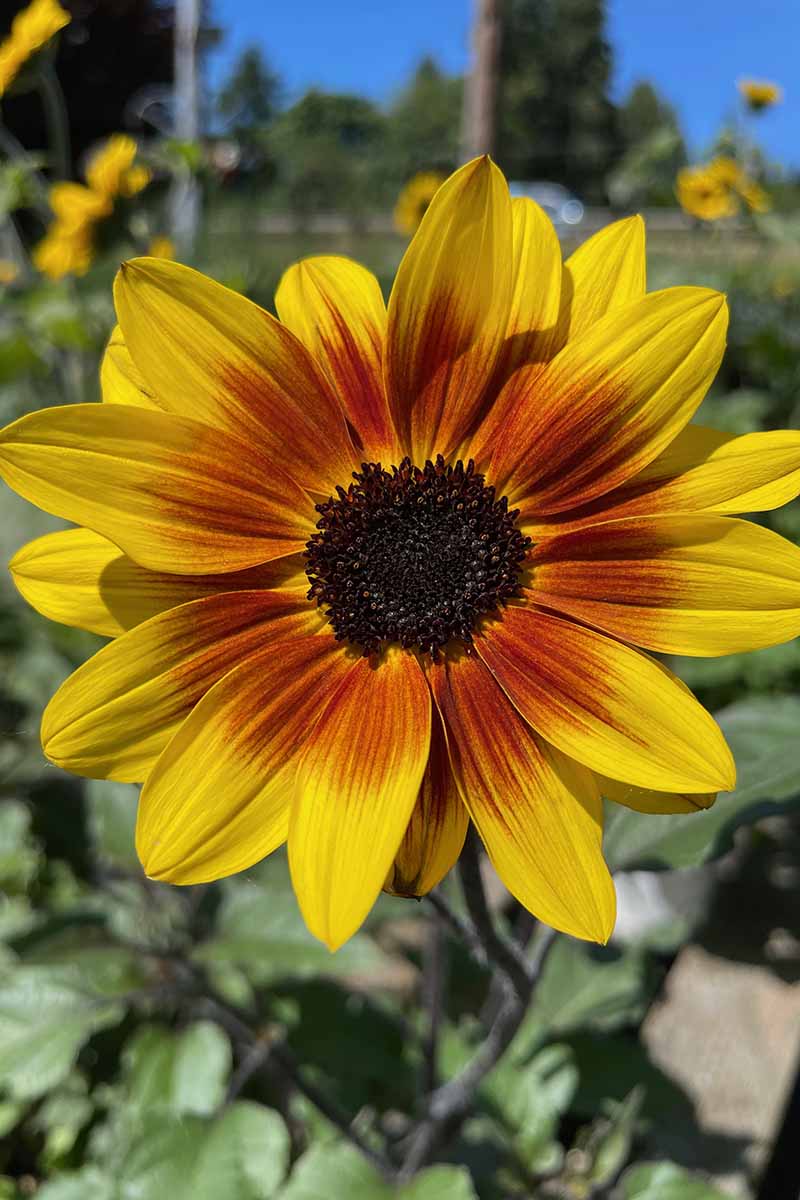
The flowers have a nutty, floral flavor that fits right into pastas, salads, meat dishes, and soups. Whenever a recipe calls for sunflower oil, I add a few petals, just for fun.
Find out how to grow sunflowers here.
62. Sweet Alyssum
Lobularia maritima, commonly known as sweet alyssum, comes in clusters of white, yellow, pink, or purple four-petalled flowers.
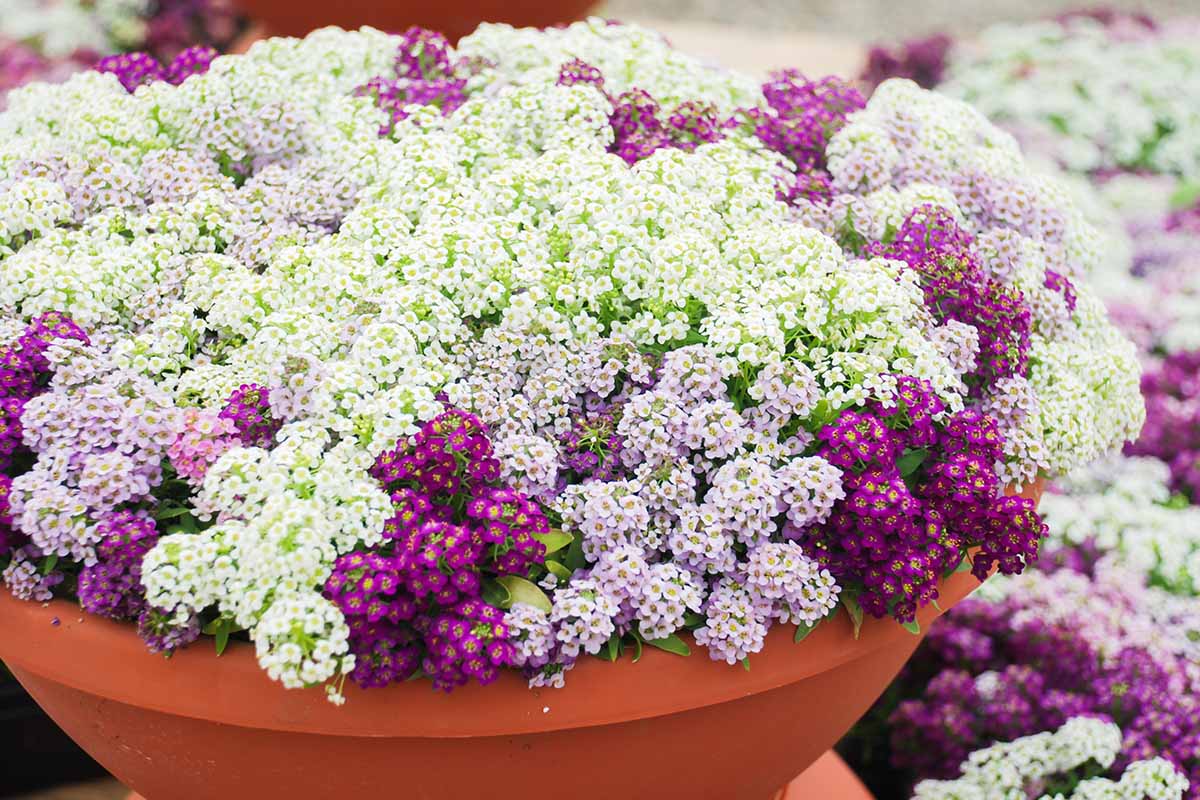
This lovely garden staple is a member of the Brassicaceae family, so it shouldn’t come as a surprise that it’s delicious. It has a sweet, peppery flavor.
In addition to making an excellent garnish, it can be used in soups, salads, and desserts.
This species is not to be confused with mountain alyssum (Alyssum montanum), which is also technically edible but not tasty.
Learn how to grow sweet alyssum in our guide.
63. Sweet William
Don’t ask me why you constantly see nasturtiums and violets being sold as edible flowers, but you rarely see sweet williams (Dianthus barbatus) marketed this way in grocery stores.
Sure, you’re likely to come across bouquets of carnations to add to a vase, and these may be edible if they’re not treated with anything. But shoppers are really missing out!

Flowers from this genus are some of the tastiest out there. Maybe we need to start a campaign.
Sweet williams have a spicy, sweet flavor that works well in sweet and savory dishes of all kinds. Candy them, toss them in salads, soups, and cocktails, or cover a cheese log with petals and serve it with crackers.
Check out our guide to growing dianthus for more information about these flowers.
65. Tulip
Tulips (Tulipa spp.) are underappreciated in the kitchen. I get it. They’re so pretty that maybe some gardeners don’t even want to imagine eating them.
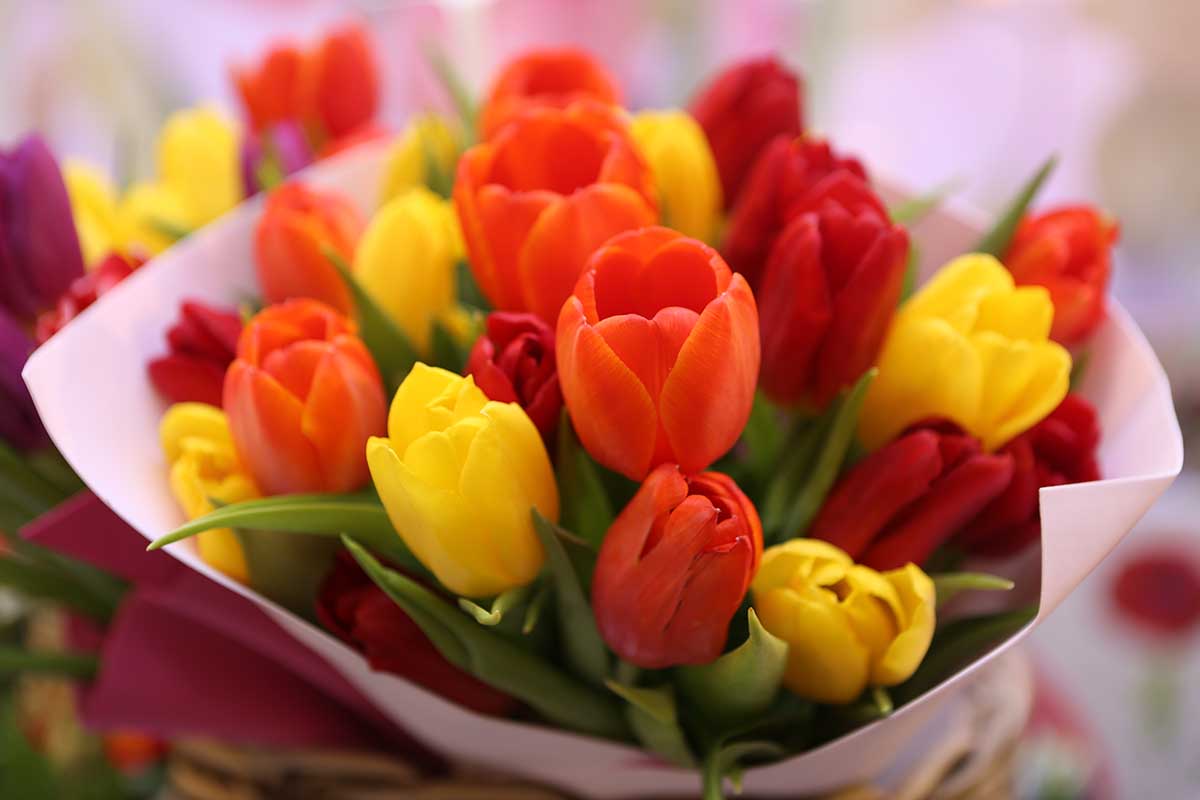
But they have a marvelous flavor that is a mix of asparagus and English peas. Any culinary creation that could use a hint of those flavors – like egg dishes, salads, veggie dishes, or chicken salad – is fair game.
The petals of some varieties are quite firm, which makes them perfect as a potato chip alternative. Or stuff them as you would endive or lettuce leaves.
You can learn how to grow tulips in our complete guide.
66. Violet
Violets (Viola spp.) are another one of those flowers that appears in every garden but rarely in any kitchen dishes.
Wild violets are tastier but these are generally going to be harder to get your hands on. If you’re up for some foraging and know of a good place to pick, have at it!
Whether cultivated or wild, don’t dry them or sit on them for too long after picking. These close relatives of pansies are best enjoyed fresh.
If you can’t eat them right away, wrap the flowers in damp paper towels or float them in a bowl of cold water.
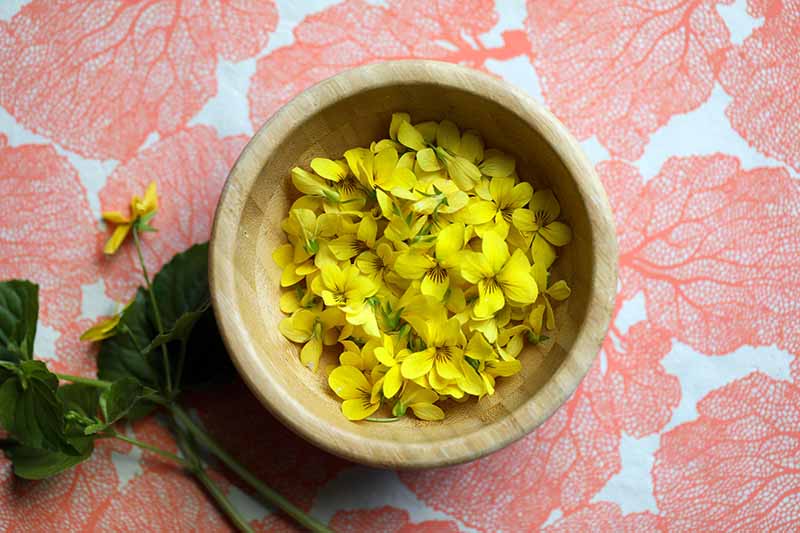
Some other types of flowers require prep in the form of removing the centers or bases first, but you can pop entire violets in your mouth straight off the plant.
These are a classic option for desserts, especially when they’re candied, with a distinct, perfumey flavor.
You often find them in ice cream, candies, marshmallows, cakes, and cookies. But they’re excellent in savory dishes, as well. Use them in fish salad, chicken curry, egg dishes, and cheese souffle.
One of my favorite recipes for violets is from “The Forgotten Art of Flower Cookery.”
Author Leona Woodring Smith combines pineapple juice, tapioca, sugar, grated lemon peel, raspberries, oranges, orange liqueur, and fresh violets to make a soup. It’s phenomenal.

The Forgotten Art of Flower Cookery
While the book is out of print, you can pick up a copy at used bookstores or find it on Amazon. It’s a must-have if you want to expand your flower cookery repertoire.
64. Sweet Woodruff
I have a soft spot for sweet woodruff (Galium odoratum) because the shady areas of my dry Utah garden were extremely hard to fill with anything but hostas. I love a good hosta, but sometimes you need something different.
I dug up a clump of sweet woodruff from my grandma’s yard and put it in my own soil. Within a few years, I had a beautiful green carpet of this wonderful herb.
One person’s (somewhat) invasive ground cover is another’s shady savior, right?

Sweet woodruff has a mild, hay-like flavor, and it can be a touch bitter. May wine is perhaps the most famous use of these flowers in the kitchen.
Years ago, the pleasant-smelling leaves, stems, and flowers were used as a mattress stuffing, which earned this plant the nickname sweet-scented bedstraw.
You can use the flowers to infuse tea or honey, sprinkle them on salads or sandwiches, or use them as a garnish. Head to Foodal to learn more about using this plant in the kitchen and in your herbal medicine cabinet.
67. Yarrow
Whether you’re growing it intentionally or it’s naturalized on the roadside, yarrow blossoms (Achillea millefolium) are well worth having around.
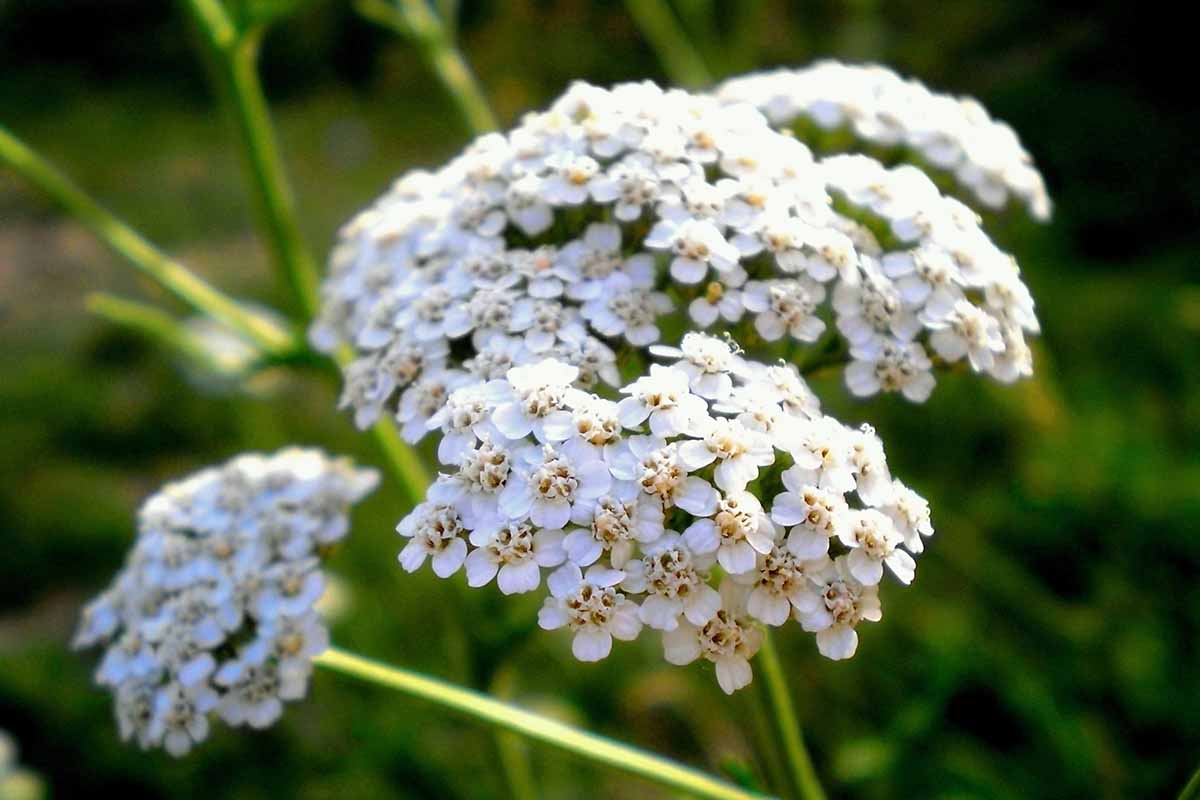
The flowers can be yellow, pink, or white in flat clusters that grow on stalks that can grow to be up to four feet tall.
The flavor is spicy and herbal, with notes of oregano combined with honeyed sweetness. Young blossoms are best as they turn bitter with age. And cooking amplifies the bitterness.
You can use dried yarrow flowers in tea and cocktails, or enjoy them fresh in pasta and rice dishes.
Some other Achillea species are edible, but stick with common yarrow. It has the best flavor.
68. Yucca
Most people in the US haven’t yet caught on to how fantastic yucca flowers are as edibles, but Native Americans and Mexicans make good use of Yucca bachata, and the blooms of all species in the genus are edible.
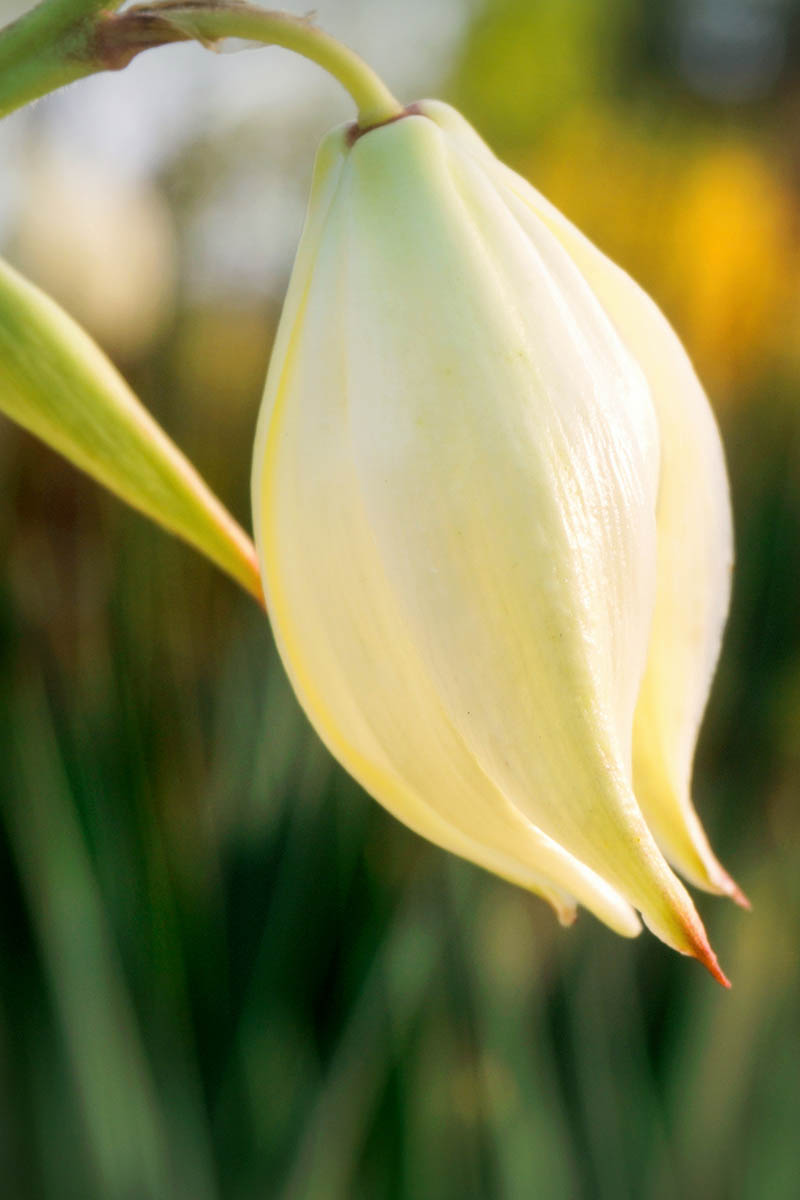
In Mexico, flor de izote (aka yucca flower) is used in steak, egg, and chicken dishes, whereas in El Salvador, it’s most popular in egg dishes, aka flor de izote con huevos.
The flowers are mildly sweet with an asparagus-like flavor. However, all other parts of the plant except the fruits of certain species are toxic, so use caution.
Our guide provides cultivation instructions.
69. Zinnia
A South American native, Zinnia elegans or the common zinnia has bright orange, yellow, red, or magenta flowers with rows and rows of petals.

The flavor is slightly bitter, so use the petals sparingly or candy them to mask the bitterness.
Learn more about zinnias and how to grow them in our guide.
A Feast for the Eyes and the Mouth
Most of us wish we had more space and time, which is why growing plants that can do double-duty in some way is so appealing.
But even if you aren’t growing any of these species already and you’re simply looking for a way to expand your cooking horizons, foraging for many of these is also possible.

Edible flowers are a feast for the eyes and the mouth. There’s something special about tucking into a dish of flowers that brings to mind lazy summer afternoons, or the optimism of spring.
But the species listed above aren’t just good as garnishes. Most are supremely flavorful in their own right, with many of them just waiting to be rediscovered as a worthy ingredient.
So tell us: what types of flowers are you going to dine on? Did we miss any that you particularly love? How do you use your edible flowers? Let us know in the comments.
And if you’re looking for more information about growing flowers in your garden, check out these guides next:
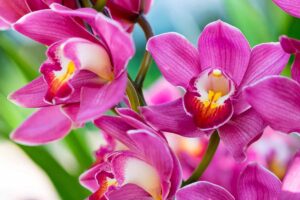
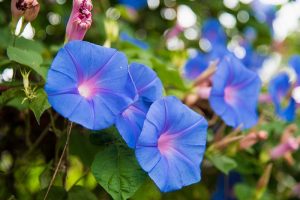
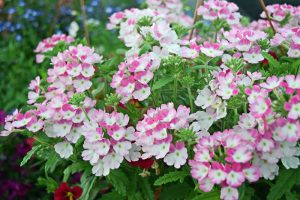
So informative; thank you
Thanks for reading, Patricia!
What about goldenrod flowers and Queen Anne’s lace? I use the later for tea. Or Heal-All?
Hi Ruby, all are excellent options! Thank you so much for reminding us! It’s that time of year when Queen Anne’s lace is flowering everywhere around me. I like to batter and fry the blossoms up. Delicious! I don’t usually recommend it to people new to foraging because it has a deadly lookalike in poison hemlock (Conium maculatum). But those who plant it themselves should enjoy it! Goldenrod (Solidago spp.) is fantastic, too. I like to crumble the flowers onto tomato soup. It’s such a pretty contrast of colors. How do you use it? And good old self heal/heal all… Read more »